Sony Group UTXB03A UHF SYNTHESIZED TRANSMITTER User Manual UWP D11 D12 D16
Sony Corporation UHF SYNTHESIZED TRANSMITTER UWP D11 D12 D16
Contents
- 1. 05 User Manual
- 2. 05 User Manual_Operating Instructions
05 User Manual_Operating Instructions

Wireless Microphone
Package
Operating Instructions
Before operating the unit, please read this manual thoroughly
and retain it for future reference.
UWP-D11/D12/D16
UTX-B03
UTX-M03
UTX-P03
URX-P03
4-530-735-16 (1)
© 2014 Sony Corporation

Table of Contents
2
Table of Contents
Configuration of the Packages ..................3
UWP-D11 ..................................................... 3
UWP-D12 ..................................................... 4
UWP-D16 ..................................................... 5
Models available separately.......................... 6
Features .......................................................7
UWP-D11 ..................................................... 7
UWP-D12 ..................................................... 7
UWP-D16 ..................................................... 7
Name and Function of Parts.......................8
Body-pack transmitter (UTX-B03)............... 8
Hand-held microphone (UTX-M03)............. 9
Plug-on transmitter (UTX-P03).................. 11
Portable diversity tuner (URX-P03) ........... 12
Power Supply.............................................14
Inserting the batteries.................................. 14
Supplying power from a USB connector.... 15
Charging nickel metal hydride batteries..... 16
Attaching Accessories..............................16
Attaching accessories to the body-pack
transmitter (UTX-B03)...................... 16
Attaching accessories to the hand-held
microphone (UTX-M03) ................... 17
Attaching accessories to the plug-on
transmitter (UTX-P03) ...................... 17
Attaching accessories to the portable
diversity tuner (URX-P03) ................ 18
Operation ...................................................19
If noise is generated .................................... 19
Tuner Settings ...........................................20
Menu structure and operation ..................... 20
Setting the receive channel ......................... 21
Searching for available channels within a
group (Clear Channel Scan) .............. 21
Searching for active channels within a group
(Active Channel Scan) ...................... 22
Adjusting the monitor audio level .............. 22
Configuration menu.................................... 23
Transmitter Settings .................................25
Menu structure and operation ..................... 25
Setting the transmit channel........................ 26
Configuration menu.................................... 27
System Configuration Examples .............30
Error Messages .........................................31
Troubleshooting........................................32
Important Notes on Use............................34
Usage and storage ....................................... 34
Cleaning...................................................... 34
Specifications............................................34
Transmitter (UTX-B03/M03/P03).............. 34
Tuner........................................................... 36
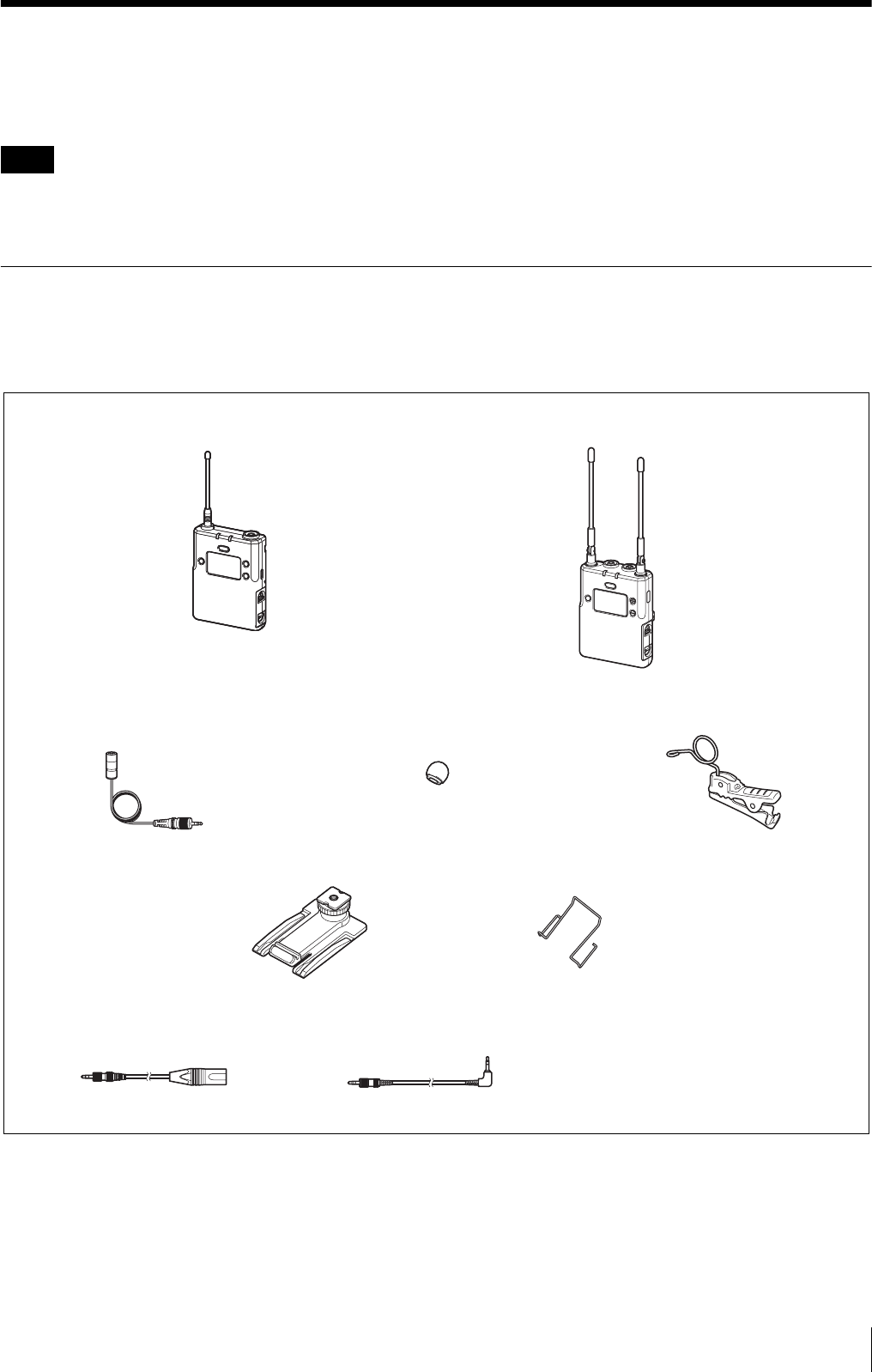
Configuration of the Packages 3
Configuration of the Packages
This manual is for the UWP-D11/D12/D16 Wireless Microphone Packages. The contents of each package are described
below.
Some of the packages may not be available in certain countries or areas.
For details, consult your Sony dealer.
UWP-D11
The package consists of a body-pack transmitter (UTX-B03), a portable diversity tuner (URX-P03), and their accessories.
When used in conjunction with a compact camcorder, a mobile system for ENG (Electronic News Gathering) or EFP
(Electronic Field Production) applications can be constructed.
Note
Body-pack transmitter
(UTX-B03) (1)
Portable diversity tuner
(URX-P03) (1)
Supplied accessories
Wind screen (1)Omni-directional lavalier microphone (1) Holder clip (1)
Shoe mount adapter (1) Belt clip (2)
Battery case (1)
(Chinese model only)
Before Use (1)
Quick Start Guide (1)
CD-ROM (1)
Warranty card (1)
(North American and Korean models only)
Stereo mini plug-BMP conversion
cable (1)
XLR-BMP conversion output cable
for the URX-P03 (1)
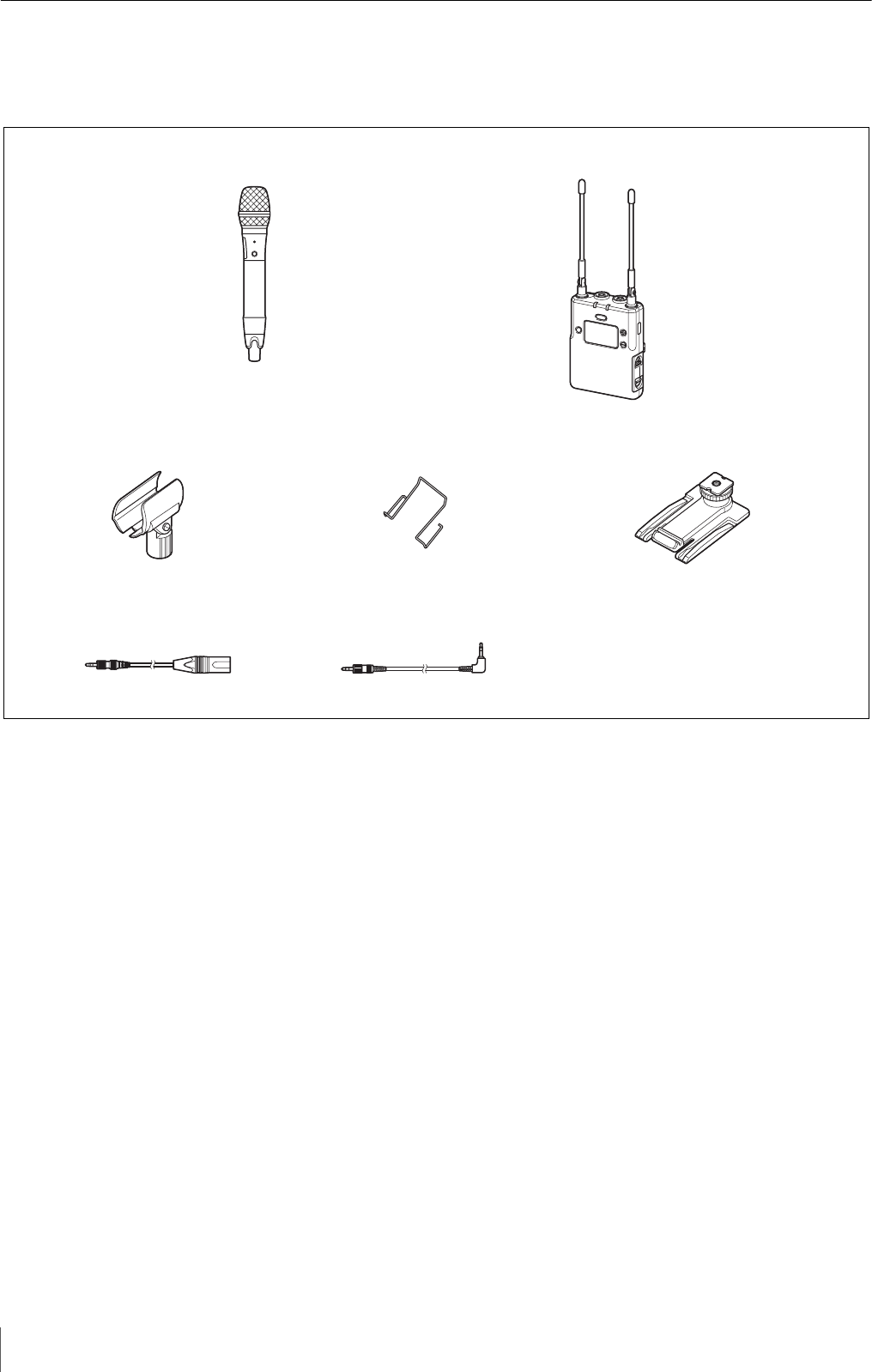
Configuration of the Packages
4
UWP-D12
The package consists of a hand-held microphone (UTX-M03), a portable diversity tuner (URX-P03), and their accessories.
When used in conjunction with a compact camcorder, a mobile system for ENG (Electronic News Gathering) or EFP
(Electronic Field Production) applications can be constructed.
Microphone holder (1)
XLR-BMP conversion output cable
for the URX-P03 (1)
Shoe mount adapter (1)Belt clip (1)
Battery case (1)
(Chinese model only)
Before Use (1)
Quick Start Guide (1)
CD-ROM (1)
Warranty card (1)
(North American and Korean models only)
Stereo mini plug-BMP conversion
cable (1)
Supplied accessories
Hand-held microphone
(UTX-M03) (1)
Portable diversity tuner
(URX-P03) (1)
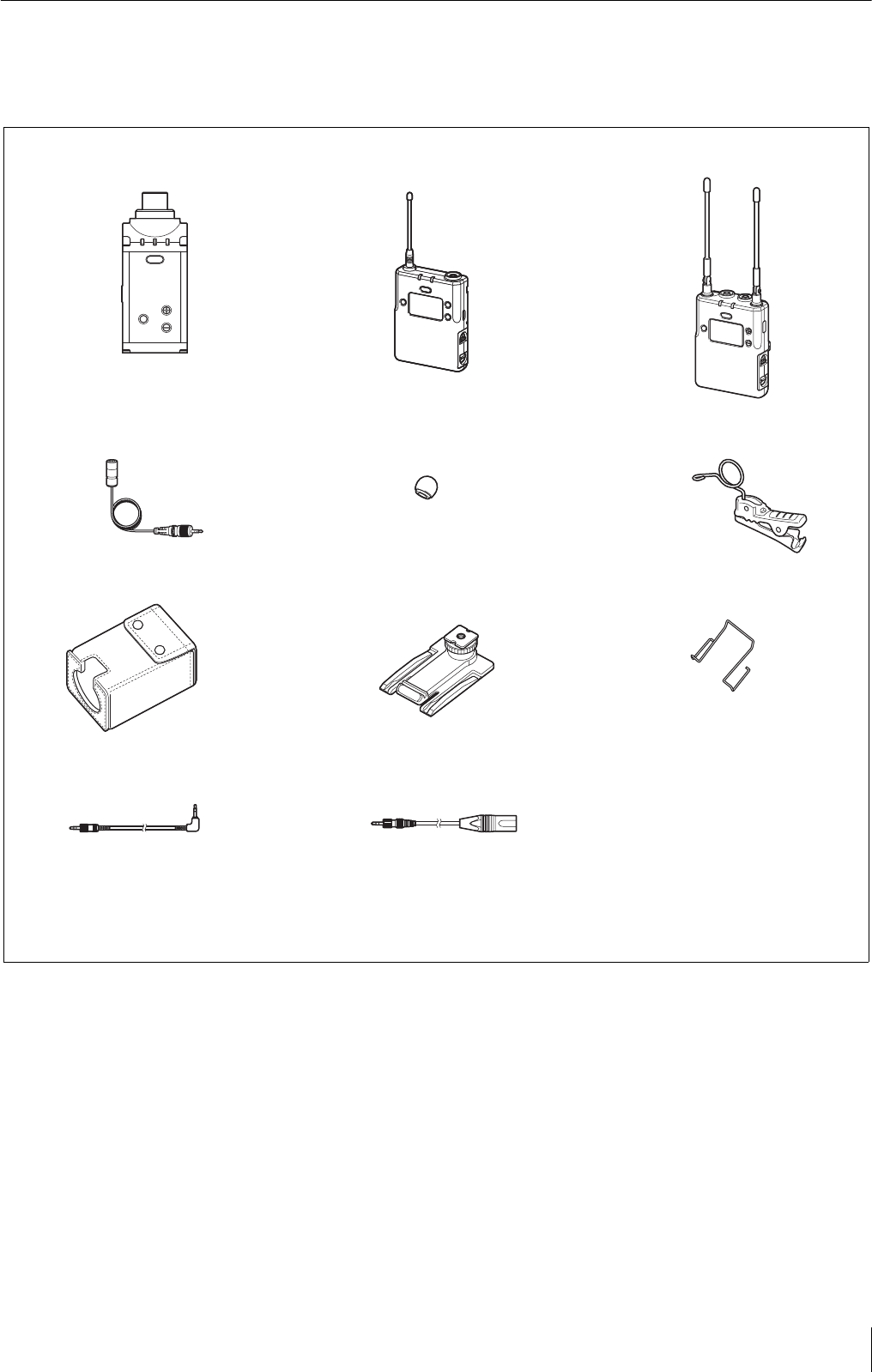
Configuration of the Packages 5
UWP-D16
The UWP-D16 consists of a plug-on transmitter (UTX-P03), a body-pack transmitter (UTX-B03), a portable diversity
tuner (URX-P03), and their accessories. When used in conjunction with a compact camcorder, a mobile system for ENG
(Electronic News Gathering) or EFP (Electronic Field Production) applications can be constructed.
Body-pack transmitter
(UTX-B03) (1)
Portable diversity tuner
(URX-P03) (1)
Supplied accessories
Soft case (1)
Plug-on transmitter
(UTX-P03) (1)
Shoe mount adapter (1) Belt clip (2)
Wind screen (1) Holder clip (1)
Stereo mini plug-BMP
conversion cable (1)
XLR-BMP conversion output cable for the
URX-P03 (1)
Omni-directional lavalier microphone (1)
Before Use (1)
Quick Start Guide (1)
CD-ROM (1)
Warranty card (1) (North American and Korean models only)

Configuration of the Packages
6
Models available separately
The transmitter and tuner in each package are available
for purchase separately. The components provided with
each product are given below.
UTX-B03
• Body-pack transmitter (UTX-B03) (1)
• Omni-directional lavalier microphone (1)
• Wind screen (1)
• Holder clip (1)
• Belt clip (1)
• Battery case (1) (Chinese model only)
• Before Use (1)
•CD-ROM (1)
• Warranty card (1) (North American and Korean models
only)
UTX-M03
• Hand-held microphone (UTX-M03) (1)
• Microphone holder (1)
• Before Use (1)
•CD-ROM (1)
• Warranty card (1) (North American and Korean models
only)
UTX-P03
• Plug-on transmitter (UTX-P03) (1)
• Soft case (1)
• Before Use (1)
•CD-ROM (1)
• Warranty card (1) (North American and Korean models
only)
URX-P03
• Portable diversity tuner (URX-P03) (1)
• Shoe mount adapter (1)
• Belt clip (1)
• XLR-BMP conversion output cable for the URX-P03
(1)
• Stereo mini plug-BMP conversion cable (1)
• Battery case (1) (Chinese model only)
• Before Use (1)
•CD-ROM (1)
• Warranty card (1) (North American and Korean models
only)

Features 7
Features
The UWP-D11/D12/D16 (UWP-D series) Wireless
Microphone Packages comprise a transmitter (body-pack
transmitter (UTX-B03), hand-held microphone
(UTX-M03), or plug-on transmitter (UTX-P03)) and a
receiver (portable diversity tuner (URX-P03)). In
combination with a compact camcorder or
interchangeable-lens digital camera, the packages can be
used for various purposes, such as ENG (Electronic News
Gathering), EFP (Electronic Field Production), sports
events, and weddings.
They are equipped with a DSP for transmission of high-
quality sound using digital compander processing. They
can be used in combination with current Sony analog
wireless microphone systems (UWP series, WRT series,
WRR series, WRU series) by switching the compander
mode.
The frequency and compander mode set on the tuner can
be sent to the transmitter using an infrared
communications link. Used in combination with the Clear
Channel Scan function of the tuner, this greatly reduces
the time required to set channels.
The contents of each package are described below.
UWP-D11
Body-pack transmitter (UTX-B03)
This transmitter is a lightweight, compact transmitter that
employs a crystal-controlled PLL synthesizer. It is
equipped with a muting function and a BMP-type
microphone input connector. The RF power output can be
switched between high and low. It is also equipped with a
MIC/LINE input switching function to support a variety
of input levels.
Portable diversity tuner (URX-P03)
This tuner employs a true diversity method featuring little
signal dropout and an angle-adjustable antenna. It comes
with an adapter for mounting on a compact camcorder
(HXR-NX3, etc.). It also features a Clear Channel Scan
function to search for available channels automatically.
UWP-D12
Hand-held microphone (UTX-M03)
This microphone features a robust, metallic body. It has a
muting function and attenuator adjustment function to
support a wide audio input level range.
It can be used in diverse applications simply by changing
the microphone capsule. It has a built-in antenna.
* Microphone unit mounting dimensions: 31.3 mm
diameter, 1.0 mm pitch
Portable diversity tuner (URX-P03)
This tuner employs a true diversity method featuring little
signal dropout and an angle-adjustable antenna. It comes
with an adapter for mounting on a compact camcorder
(HXR-NX3, etc.). It also features a Clear Channel Scan
function to search for available channels automatically.
UWP-D16
Plug-on transmitter (UTX-P03)
This transmitter is a lightweight, compact plug-on type
transmitter that employs a crystal-controlled PLL
synthesizer. It has a muting function and an XLR-type
microphone input connector that can supply +48 V power
for connecting a wide range of microphones. It is also
equipped with a MIC/LINE switching function to support
a variety of input levels.
Body-pack transmitter (UTX-B03)
This transmitter is a lightweight, compact transmitter that
employs a crystal-controlled PLL synthesizer. It is
equipped with a muting function and a BMP-type
microphone input connector. The RF power output can be
switched between high and low. It is also equipped with a
MIC/LINE input switching function to support a variety
of input levels.
Portable diversity tuner (URX-P03)
This tuner employs a true diversity method featuring little
signal dropout and an angle-adjustable antenna. It comes
with an adapter for mounting on a compact camcorder
(HXR-NX3, etc.). It also features a Clear Channel Scan
function to search for available channels automatically.
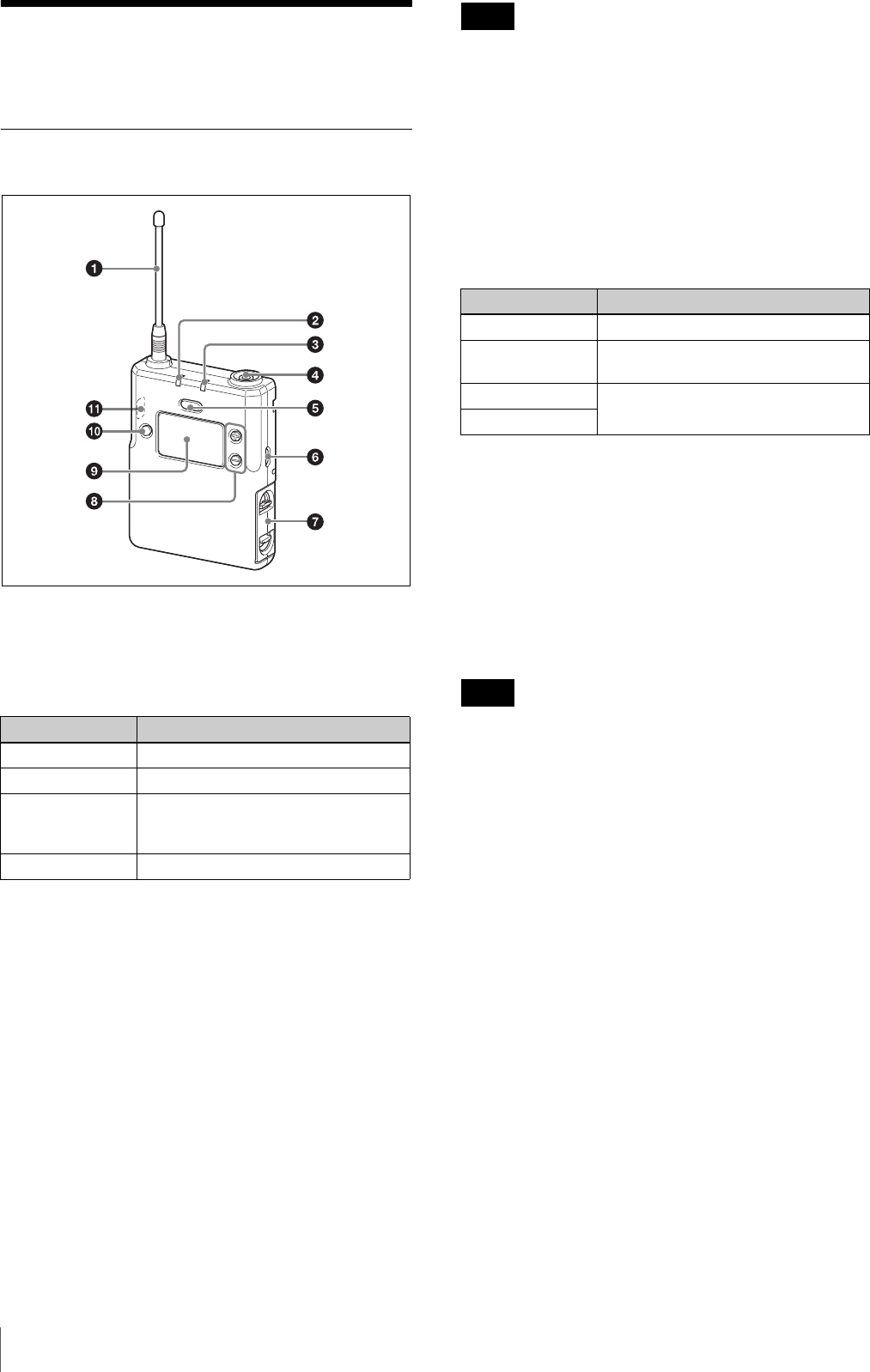
Name and Function of Parts
8
Name and Function of
Parts
Body-pack transmitter (UTX-B03)
aAntenna
bPOWER indicator
Displays the battery level and charging status.
cAUDIO (audio input level) indicator
Turns on or off according to the audio input level as
follows.
On (red): Audio input level is too high. If the sound is
distorted, adjust the attenuation level to decrease the
audio input level (page 27).
On (green): Audio input level is appropriate.
Off: There is no audio input or the input level is too low.
Flashing (orange): Audio is muted (i.e., disabled).
dAudio input connector (BMP type)
Connect to the supplied lavalier microphone.
• When the audio input level is set to MIC, a voltage for
the lavalier microphone power supply is applied to the
audio input connector. Special electrical wiring is used
inside the audio input connector for this purpose.
• If a lavalier microphone other than the one supplied is
connected, the proper performance may not be
obtained.
ePOWER/MUTING button
Turns the power on/off. You also use this button to turn
the muting function on/off.
fUSB connector (Micro B type)
Connect to a commercially available USB portable power
supply.
When a USB portable power supply is connected while
the power is turned on, the unit automatically operates
with power supplied by the USB portable power supply.
When a USB portable power supply is connected while
nickel metal hydride batteries are inserted and the power
is turned off, the batteries are charged by the USB
portable power supply.
Alkaline batteries and lithium batteries cannot be
recharged.
gBattery compartment
Accepts two AA batteries (alkaline, nickel metal hydride,
or lithium batteries).
For details on how to insert batteries, see “Power
Supply” (page 14).
h+ or – button
Selects functions or values shown on the display.
Indicator display Status
On (green) Sufficient battery level
Flashing (green) Battery is getting low
On (orange) Charging (when nickel metal hydride
rechargeable batteries are inserted
and power is turned off)
Off Power is off or battery is empty
Notes
Function Operation
Supply ON Press button for one second or longer
Supply OFF Press button until the indicator turns
off
Muting ON Press button
Muting OFF
Note
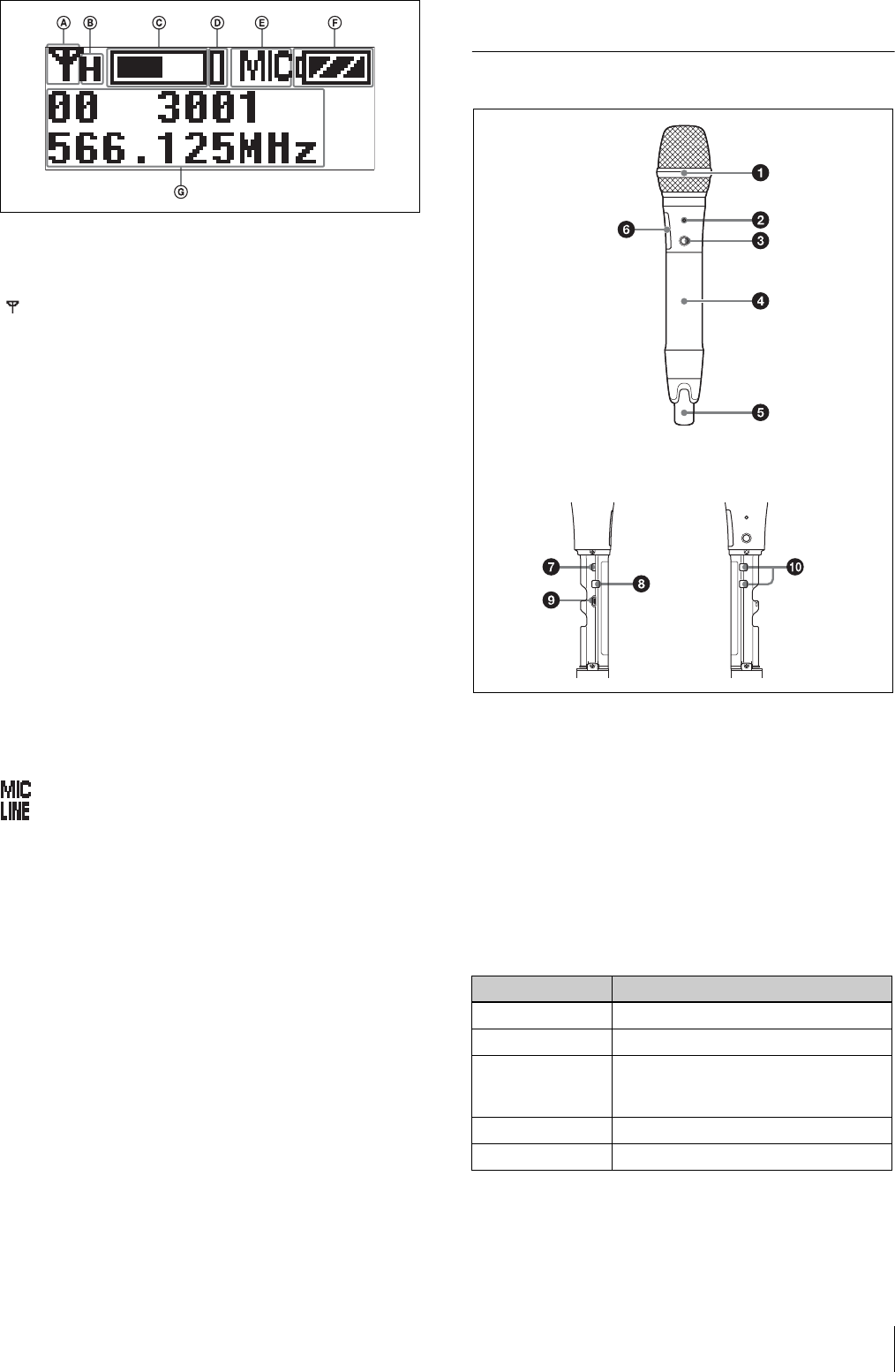
Name and Function of Parts 9
iDisplay section
ARF transmission indicator
Displays the current transmission status.
BRF transmission power indicator
Indicates the current transmission power setting. You can
change the setting with the RF transmission power setting
function.
For details on the RF transmission power setting
function, see “Setting the transmit output level (RF
POWER)” (page 27).
CAudio input level meter
Displays the audio input level.
DPeak indicator
Lights up when the signal is 3 dB below the level at which
distortion begins as a warning of excessive input level.
EInput level indicator
Displays the input level status.
: Microphone input
: Line input
FBattery level indicator
Displays the battery level. Displays “EXT” when power
is supplied from the USB connector.
For details, see “Battery level indicator” (page 15).
GMenu display section
Displays various functions. Press the + or – button to
switch functions.
For details, see “Configuration menu” (page 23).
jSET button
Adjusts displayed function settings and enters the
displayed value.
Holding down the SET button while turning on the power
turns the transmitter on without transmitting a signal
(transmission stopped mode).
kInfrared detector
Receives the frequency and compander mode set on the
tuner.
Hand-held microphone (UTX-M03)
aMicrophone unit
The standard-equipped microphone unit can be
interchanged with another microphone unit having a
diameter of 31.3 mm and a pitch of 1.0 mm.
For details on attaching and removing the microphone
unit, see “Replacing the microphone unit” (page 17).
bPOWER indicator
Displays the battery level, charging status, and audio
muting (i.e., audio enabled or disabled) status.
: Transmitting
– : Transmission stopped
Indicator display Status
On (green) Sufficient battery level
Flashing (green) Battery is getting low
On (orange) Charging (when nickel metal hydride
rechargeable batteries are inserted
and power is turned off)
Off Power is off or battery is empty
Flashing (orange) Audio is muted (i.e., disabled)
Inside the grip
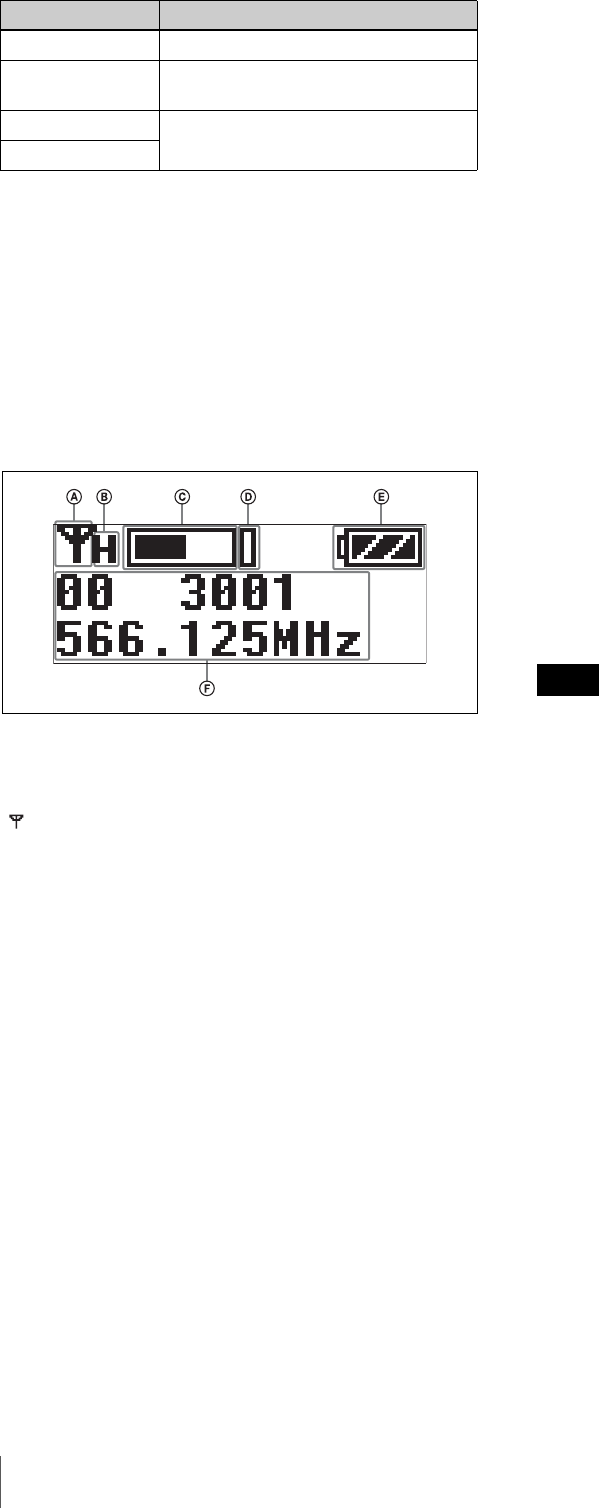
Name and Function of Parts
10
cPOWER/MUTING button
Turns the power on/off. You also use this button to turn
the muting function on/off.
dBattery compartment
Accepts two AA batteries (alkaline, nickel metal hydride,
or lithium batteries).
For details on how to insert batteries, see “Power
Supply” (page 14).
eAntenna section
fDisplay section
ARF transmission indicator
Displays the current transmission status.
BRF transmission power indicator
Indicates the current transmission power setting. You can
change the setting with the RF transmission power setting
function.
For details on the RF transmission power setting
function, see “Setting the transmit output level (RF
POWER)” (page 27).
CAudio input level meter
Displays the audio input level.
DPeak indicator
Lights up when the signal is 3 dB below the level at which
distortion begins as a warning of excessive input level.
EBattery level indicator
Displays the battery level.
For details, see “Battery level indicator” (page 15).
FMenu display section
Displays various functions. Press the + or – button to
switch functions.
For details, see “Configuration menu” (page 23).
gInfrared detector
Receives the frequency and compander mode set on the
tuner.
hSET button
Adjusts displayed function settings and enters the
displayed value.
Holding down the SET button while turning on the power
turns the transmitter on without transmitting a signal
(transmission stopped mode).
iUSB connector (Micro B type)
Connect to a commercially available USB portable power
supply.
When a USB portable power supply is connected while
nickel metal hydride batteries are inserted and the power
is turned off, the batteries are charged by the USB
portable power supply.
Alkaline batteries and lithium batteries cannot be
recharged. Also, power cannot be supplied from a USB
portable power supply.
j+ or – button
Selects functions or values shown on the display.
Function Operation
Supply ON Press button for one second or longer
Supply OFF Press button until the indicator turns
off
Muting ON Press button
Muting OFF
: Transmitting
– : Transmission stopped
Note

Name and Function of Parts 11
Plug-on transmitter (UTX-P03)
aAudio input connector (XLR type)
Connect to a microphone or the line output of an audio
mixer or other device.
b+48V (+48 V supply) indicator
Lights up when the unit is set to LINE input and is
supplying power to the connected microphone.
cPOWER indicator
Displays the battery level and charging status.
dAUDIO (audio input level) indicator
Turns on or off according to the audio input level as
follows.
On (red): Audio input level is too high. If the sound is
distorted, adjust the attenuation level to decrease the
audio input level (page 27).
On (green): Audio input level is appropriate.
Off: There is no audio input or input level is too low.
Flashing (orange): Audio is muted (i.e., disabled).
ePOWER/MUTING button
Turns the power on/off. You also use this button to turn
the muting function on/off.
fDisplay section
ARF transmission indicator
Displays the current transmission status.
BRF transmission power indicator
Indicates the current transmission power setting. You can
change the setting with the RF transmission power setting
function.
For details on the RF transmission power setting
function, see “Setting the transmit output level (RF
POWER)” (page 27).
CAudio input level meter
Displays the audio input level.
DPeak indicator
Lights up when the signal is 3 dB below the level at which
distortion begins as a warning of excessive input level.
EInput level indicator
Displays the input level status.
: Microphone input
: Line input
FBattery level indicator
Displays the battery level. Displays “EXT” when power
is supplied from the USB connector.
For details, see “Battery level indicator” (page 15).
Indicator display Status
On (green) Sufficient battery level
Flashing (green) Battery is getting low
On (orange) Charging (when nickel metal hydride
rechargeable batteries are inserted
and power is turned off)
Off Power is off or battery is empty
Front
Bottom
Function Operation
Supply ON Press button for one second or longer
Supply OFF Press button until the indicator turns
off
Muting ON Press button
Muting OFF
: Transmitting
– : Transmission stopped
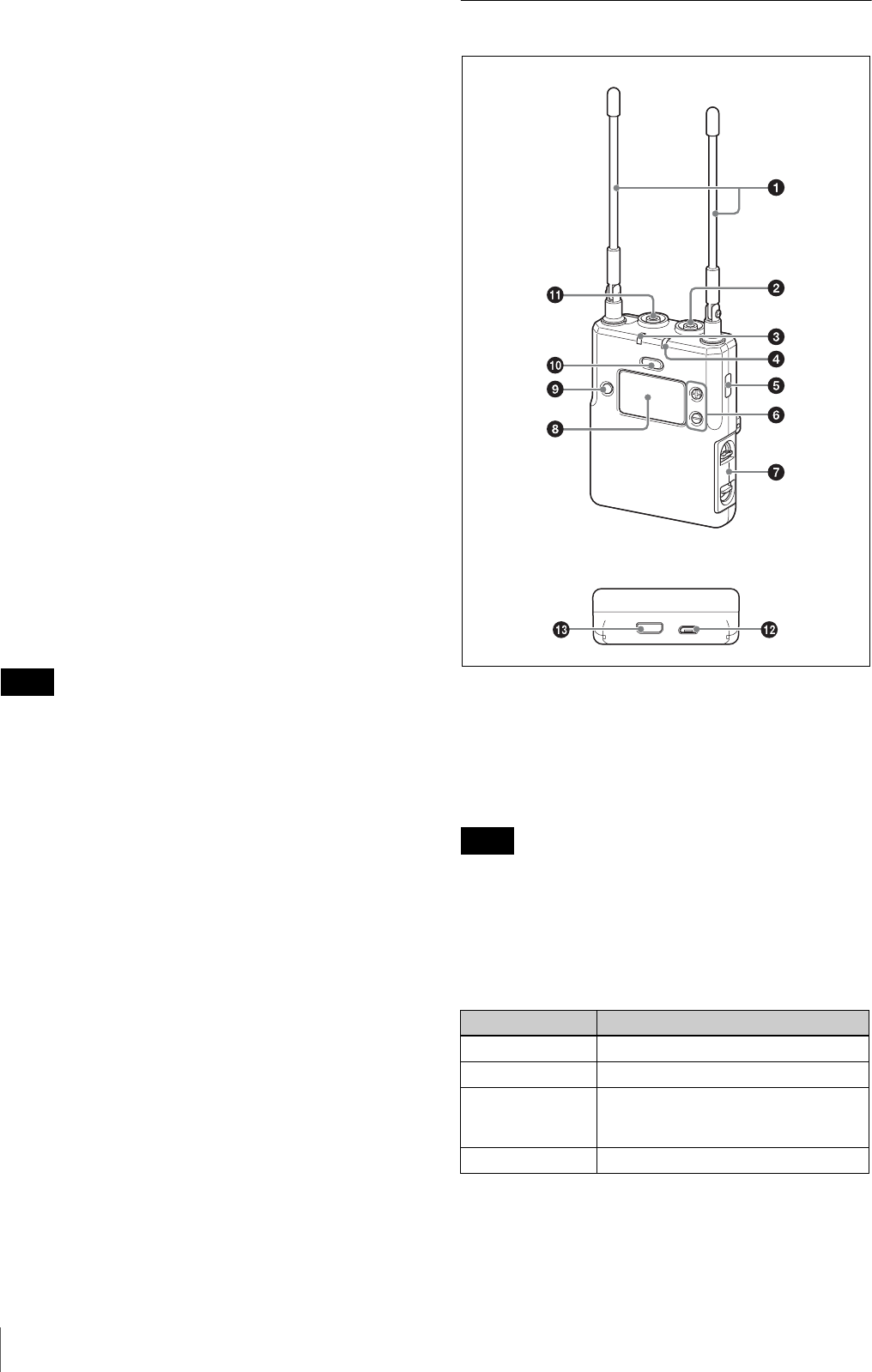
Name and Function of Parts
12
GMenu display section
Displays various functions. Press the + or – button to
switch functions.
For details, see “Configuration menu” (page 23).
g+ or – button
Selects functions or values shown on the display.
hSET button
Adjusts displayed function settings and enters the
displayed value.
Holding down the SET button while turning on the power
turns the transmitter on without sending a signal
(transmission stopped mode).
iInfrared detector
Receives the frequency and compander mode set on the
tuner.
jUSB connector (Micro B type)
Connect to a commercially available USB portable power
supply.
When a USB portable power supply is connected while
the power is turned on, the unit automatically operates
with power supplied by the USB portable power supply.
When a USB portable power supply is connected while
nickel metal hydride batteries are inserted and the power
is turned off, the batteries are charged by the USB
portable power supply.
Alkaline batteries and lithium batteries cannot be
recharged.
kBattery compartment
Accepts two AA batteries (alkaline, nickel metal hydride,
or lithium batteries).
For details on how to insert batteries, see “Power
Supply” (page 14).
Portable diversity tuner (URX-P03)
aAntenna
bPHONES (monitor) connector (3.5-mm
diameter, stereo mini jack)
Connect to headphones to monitor the audio output.
Do not connect headphones with a monaural mini jack.
This may short-circuit the headphone outputs, resulting in
distorted sound output.
cPOWER indicator
Displays the battery level and charging status.
Note
Note
Indicator display Status
On (green) Sufficient battery level
Flashing (green) Battery is getting low
On (orange) Charging (when nickel metal hydride
rechargeable batteries are inserted
and power is turned off)
Off Power is off or battery is empty
Front
Bottom

Name and Function of Parts 13
dRF (radio frequency input) indicator
Displays the RF input level using the following colors.
On (green): Input level is 25 dBμ or more.
On (red): Input level is 15 to 25 dBμ.
Off: Input level is 15 dBμ or lower.
*0 dBμ = 1 μVEMF
eInfrared transmitter port
Sends the set frequency and compander mode to the
transmitter.
f+ or – button
Selects functions or values shown on the display.
gBattery compartment
Accepts two AA batteries (alkaline, nickel metal hydride,
or lithium batteries).
For details on how to insert batteries, see “Power
Supply” (page 14).
hDisplay section
AAudio input level meter
Displays the audio input level.
BPeak indicator
Lights up when the signal is 3 dB below the level at which
distortion begins as a warning of excessive input level.
CBattery level indicator
Displays the battery level. “EXT” is displayed when
power is supplied from the USB connector. “MI” is
displayed when power is supplied from an SMAD-P3
(not supplied).
For details, see “Battery level indicator” (page 15).
DRF level (reception level) indicator
Indicates the current reception level.
EMenu display section
Displays various functions. Press the + or – button to
switch functions.
For details, see “Configuration menu” (page 23).
iSET button
Adjusts displayed function settings and enters the
displayed value.
Holding down the SET button while turning on the power
turns the transmitter on without sending a signal
(transmission stopped mode).
jPOWER button
Turns the power on/off.
kOUTPUT (audio output) connector (3.5-mm
diameter, stereo mini jack)
Connect one end of the supplied XLR-BMP conversion
output cable for the URX-P03 or the stereo mini plug-
BMP conversion cable here and the other end to the
microphone input on a camcorder, mixer, or amplifier. If
the microphone input connector on the connected device
is a stereo mini jack, connect the straight (BMP) plug to
the tuner and the L-shaped (stereo mini) plug to the
microphone input connector on the device.
To prevent damaging the tuner, do not apply a voltage to
this connector from a microphone external power supply
or other source.
lUSB connector (Micro B type)
Connect to a commercially available USB portable power
supply.
When the power is turned on, the unit operates with
power supplied by the USB portable power supply. When
nickel metal hydride batteries are inserted and the power
is turned off, the battery is charged by the USB portable
power supply.
Alkaline batteries and lithium batteries cannot be
recharged.
mAuxiliary connector
Used to connect external accessories.
Function Operation
Supply ON Press button for one second or longer
Supply OFF Press button until the indicator turns
off
Note
Note
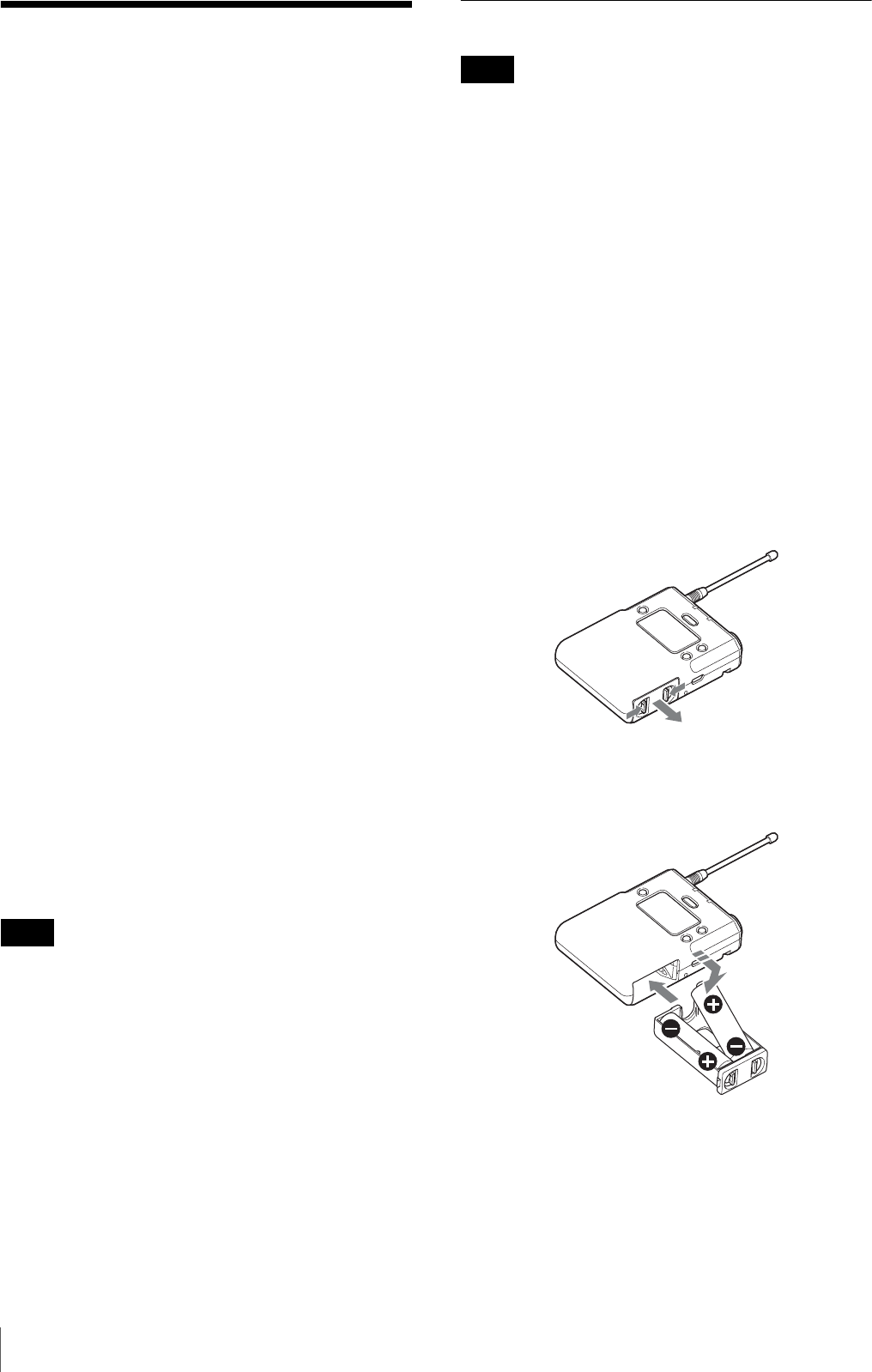
Power Supply
14
Power Supply
This section describes the power supply of each device
and the charging of nickel metal hydride batteries.
Body-pack transmitter (UTX-B03) and plug-on
transmitter (UTX-P03)
The unit operates using power supplied from two AA
batteries (alkaline, nickel metal hydride, or lithium
batteries) or from a supply connected to the USB
connector. If power is supplied simultaneously from
batteries and from a supply connected to the USB
connector, power from the USB connector has
precedence. For details about inserting batteries in each
device and displaying the battery level, or supplying
power from a supply connected to the USB connector, see
the following sections.
Hand-held microphone (UTX-M03)
The unit operates from two AA batteries (alkaline, nickel
metal hydride, or lithium batteries). For details about
inserting batteries and displaying the battery level, see the
following sections.
Portable diversity tuner (URX-P03)
The unit operates from two AA batteries (alkaline, nickel
metal hydride, or lithium batteries), power supplied from
a supply connected to the USB connector, or power
supplied from the auxiliary connector. The power supply
that has precedence when both AA battery power and an
external power supply via the USB connector or auxiliary
connector are available can be specified using the PWR
SOURCE (external power selection) function. Under the
factory default setting, the power supplied from inserted
AA batteries has precedence. For details about inserting
batteries and displaying the battery level, or supplying
power from supply connected to the USB connector, see
the following sections.
For details on the PWR SOURCE function setting, see
“Selecting the preferred power supply (PWR SOURCE)”
(page 24).
The use of manganese batteries will result in poor
performance. Do not use manganese batteries.
Inserting the batteries
• Always use sets of the same type of battery. Do not use
batteries of different types or batteries with different
charge level together.
• Replacing the batteries during operation may generate
a large noise. Be sure to turn off the unit before
replacing the batteries.
Body-pack transmitter (UTX-B03) / plug-
on transmitter (UTX-P03) / portable
diversity tuner (URX-P03)
The following describes the procedure using illustrations
for the body-pack transmitter (UTX-B03). Batteries can
be inserted in the plug-on transmitter (UTX-P03) and
portable diversity tuner (URX-P03) in the same manner.
1
Press and hold the POWER/MUTING button to turn
the power off.
2
Slide the two catches inward (as indicated) and pull
the battery compartment out.
3
Insert two new AA batteries into the battery
compartment with 3 and # polarities in the correct
orientation, and close the compartment.
Make sure that the battery compartment is locked
securely.
Note
Notes
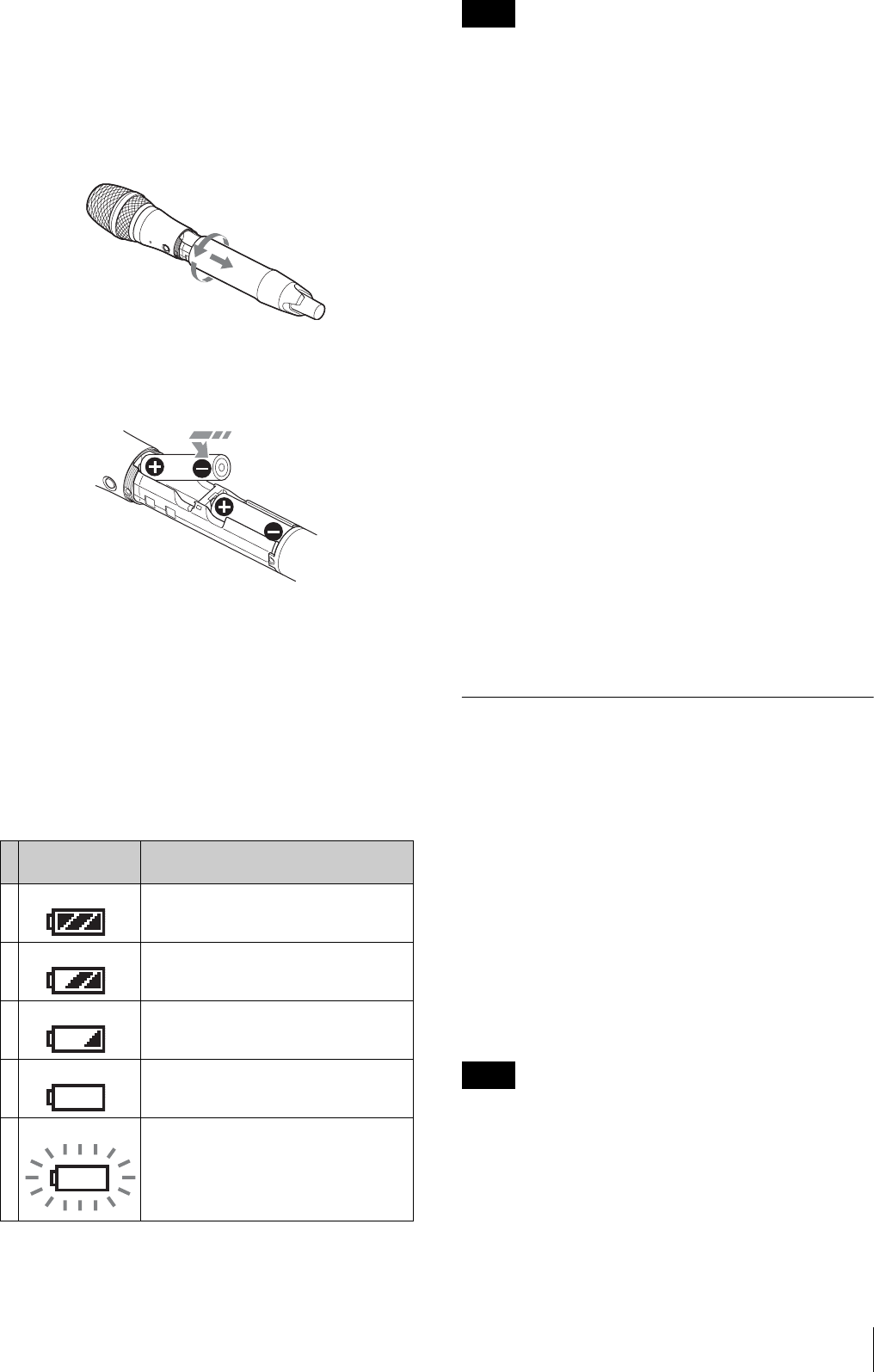
Power Supply 15
Hand-held microphone (UTX-M03)
1
Press and hold the POWER/MUTING button to turn
the power off.
2
Turn the grip in the direction of the arrow, and pull
the grip down until the battery compartment is
visible.
3
Insert two new AA batteries into the battery
compartment with 3 and # polarities in the correct
orientation.
4
Close the grip, turning it in the reverse direction of
step 2.
Battery level indicator
Press and hold the POWER button for 1 second or longer
to display the battery level on the display.
Immediately replace both batteries with new batteries if
the indicator starts flashing (indication 5 below). If using
new alkaline batteries, use after checking the
recommended time limits.
• When BATTERY is set to TYPE1, the battery level is
indicated based on the use of new LR6 (size AA) Sony
alkaline batteries. The battery level may not be
displayed correctly when different kinds of batteries,
different brand of batteries, or old batteries are used. If
using batteries other than size AA alkaline batteries,
select the battery type using the BATTERY function.
• If you plan to use the transmitter continuously for a long
period of time, it is recommended that you replace the
batteries with brand new ones.
• Battery power is gradually consumed, even when the
unit is turned off. Remove the batteries from the unit
before prolonged periods of disuse.
For details on the BATTERY function setting, see “Setting
the battery type (BATTERY)” (page 24).
Battery precautions
Batteries may leak or explode if mistreated. Be sure to
follow these instructions.
• Insert batteries in the correct 3 and # polarity
orientation.
• Always replace the two batteries together with new
ones.
• Do not use different types of batteries or old and new
ones together.
• Dry cells are not rechargeable.
• When not using the device for a long period of time,
remove the batteries. If the batteries leak for any reason,
consult your Sony service representative.
Supplying power from a USB
connector
The transmitter (UTX-B03/P03) and tuner (URX-P03)
can operate from a commercially available USB-output
type AC adapter or portable power supply connected to
the USB connector.
When supplying power using a USB-output type AC
adapter or portable power supply, use a unit that satisfies
the following conditions.
• Output connector: USB micro B type
• Rated voltage: 5 V
• Output current: 200 mA or higher
Displays “EXT” when power is supplied from the USB
connector.
• The UTX-M03 hand-held microphone cannot be
supplied using a USB connector.
• Noise may occur in the audio depending on the AC
adapter or portable power supply that is connected. In
such cases, you can reduce the noise by distancing the
unit or lavalier microphone from the AC adapter or
portable power supply or otherwise altering their
positions.
Battery level
indicator
Battery status
1Lights Good
2 Lights Less than 70% charge remaining
3 Lights Less than 40% charge remaining
4 Lights Less than 20% charge remaining
5 Flashes Almost empty
Notes
Notes

Attaching Accessories
16
Charging nickel metal hydride
batteries
You can charge nickel metal hydride batteries inserted in
the transmitter (UTX-B03/M03/P03) and tuner
(URX-P03).
When charging nickel metal hydride batteries, turn the
power off and connect a commercially available USB-
output type AC adapter or portable power supply to the
USB connector.
The POWER indicator is lit orange while charging
batteries. When charging is finished, the POWER
indicator goes off.
When charging batteries using a USB-output type AC
adapter or portable power supply, use a unit that satisfies
the following conditions.
• Output connector: USB micro B type
• Rated voltage: 5 V
• Output current: 1 A or higher
• Charging may not be supported, depending on the
connected AC adapter, portable power supply, or
computer port.
• Nickel metal hydride batteries are not charged while the
transmitter or tuner is turned on.
Attaching Accessories
This section describes how to attach the supplied
accessories to each device.
Attaching accessories to the body-
pack transmitter (UTX-B03)
Connecting the microphone
Be sure to attach or remove the microphone after turning
off the transmitter.
Attaching the holder clip to the
microphone
To secure the microphone cable
Notes
Note
For a secure connection, turn to lock the connector.
Microphone (supplied)
Push the end of the microphone
holder to expand the ring opening
(1), and insert the microphone (2).
Align the groove on the base of the
microphone with the ring, then
release the clip to secure the
microphone.
Insert the microphone cable through the
clamp of the holder clip.

Attaching Accessories 17
Attaching the wind screen to the
microphone
Attaching a belt clip
To remove a belt clip
Attaching accessories to the hand-
held microphone (UTX-M03)
Attaching the microphone holder
Replacing the microphone unit
Removing the microphone unit
Attaching the microphone unit
Turn the microphone unit in the opposite direction from
when you removed it, and make sure that the unit is
securely attached to the microphone.
Attaching accessories to the plug-
on transmitter (UTX-P03)
Attaching a microphone or cable
Align and insert the microphone
into the hole in the wind screen.
Insert one end of the belt
clip into one of two holes
on either side of the
transmitter, and then
insert the other end into
the hole on the other side.
Insert a pointed object, such as
a ball-point pen, between the
belt clip and the transmitter,
and pry the end of the belt clip
from the hole on the side of the
transmitter.
Insert the base of the
microphone into the holder.
Turn the microphone unit in the
direction of the arrow.
Push the microphone or cable connector (XLR-3-12C
connector) into the audio input connector of the
UTX-P03 until it clicks into place.
Microphone or
cable connector

Attaching Accessories
18
Disconnecting a microphone or cable
Attaching accessories to the
portable diversity tuner (URX-P03)
Connecting the conversion cable to the
OUTPUT connector
Attaching a belt clip
See “Attaching a belt clip” (page 17).
Attaching the shoe mount adapter
Attach the belt clip before attaching the shoe mount
adapter (page 17).
Attach belt clips upside-down if planning to attach the
shoe mount adapter.
If attaching a camcorder, bend the URX-P03 antenna
down so that the antenna is not reflected on the display.
To remove the shoe mount adapter
Press the release button and pull the microphone
or cable out slowly.
Release button
Microphone or
cable connector
Example: XLR-BMP conversion output
cable for the URX-P03
For a secure connection, turn to lock the
connector.
Note
Note
Push the bottom of the belt clip to make some space
between the belt clip and the tuner (1), align the belt clip
with the two vertical grooves on the shoe mount adapter, and
insert the adapter in the direction of the arrow (2). Push the
shoe mount adapter in fully until the belt clip fits into the
horizontal groove on the adapter holds.
Push and hold the part labeled “PUSH” on the shoe mount
adapter 1, and disengage the horizontal part of the belt clip
from the horizontal groove on the shoe mount adapter (2).
Then, push the shoe mount adapter in the direction of the
arrow (3).
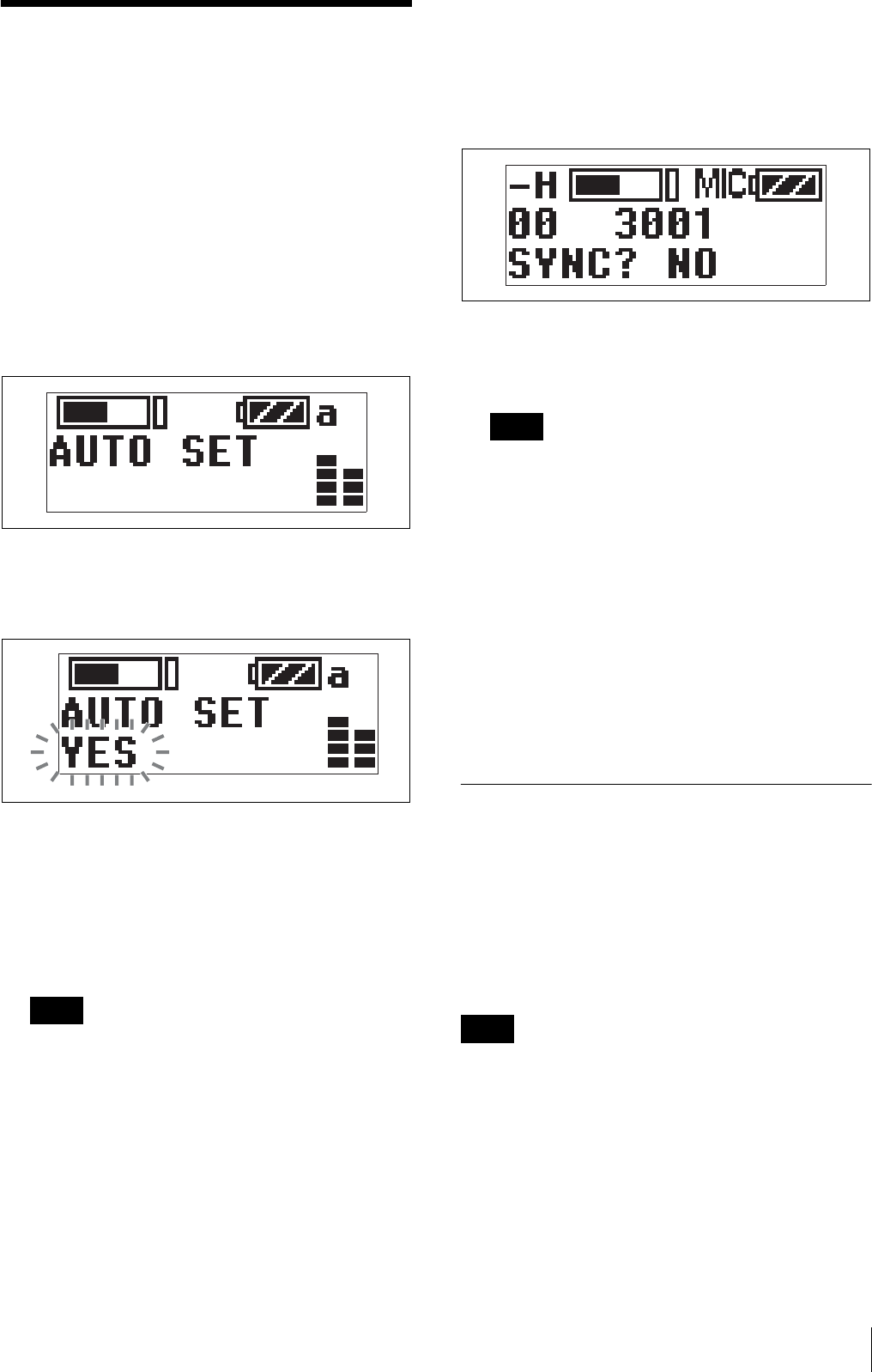
Operation 19
Operation
Procedure for UWP-D series devices (UTX-B03/
M03/P03 and URX-P03)
1
Connect the tuner as required.
For details about example connections, see “System
Configuration Examples” (page 30).
2
Press and hold the POWER button for at least one
second on the tuner to turn the power on.
3
Use the + or – button to display the AUTO SET
screen on the tuner.
4
Press and hold the SET button on the tuner for at least
one second.
“YES” flashes on the display.
5
Press the SET button on the tuner.
Clear Channel Scan starts searching for an available
channel.
When Clear Channel Scan finishes, the channel with
the least noise and interference will be set.
When the channel is set, infrared transmission starts
automatically.
Some noise may occur when power is turned on.
Accordingly, turn down the audio input level of
devices connected to the tuner when turning the
power on.
6
Press and hold the SET button on the transmitter and
press the POWER/MUTING button to turn the power
on.
7
Place the infrared transmitter port on the tuner near
the infrared detector on the transmitter.
Information about the channel set on the tuner is sent
to the transmitter, and a prompt appears on the
transmitter display asking if you want to change to
that frequency.
8
Use the + or – button to select YES, then press the
SET button on the transmitter.
This sets the transmit channel.
• The infrared transmission from the tuner in step 5
continues for about ten seconds. Perform steps 6
and 7 within those ten seconds. If ten seconds have
elapsed, you can reestablish the infrared link using
the SYNC menu on the tuner.
• Place the tuner and transmitter within about 20 cm
(8 in.) of each other.
• If five seconds elapse without any user input after
the prompt appears on the transmitter display, the
transmitter returns to its previous state without
changing the frequency.
• Communications using the infrared link may be
adversely affected, depending on the surrounding
environment. If this occurs, use the SYNC menu on
the tuner to reestablish the link.
If noise is generated
Depending on the environment where the devices are
installed, external noise or radio waves may disrupt
transmission on certain channels. When selecting a
channel under these circumstances, turn off the
transmitter. Then, on the tuner, select a channel for which
the RF indicator does not light up (i.e., a channel free
from noise or radio wave interference). Set the same
channel on the transmitter.
To prevent interference or noise, take the following
precautions.
• Do not use two or more transmitters on the same
channels.
• When operating two or more UWP-D series packages
simultaneously, set each package to a different channel
within the same channel group.
• Keep the antennas on the tuner and transmitter
separated by at least 3 meters (about 10 feet).
Note
Notes
Notes

Tuner Settings
20
• When operating two or more UWP-D series packages
simultaneously with different channel groups, make
sure that they are at least 100 meters (330 feet) apart if
they are used within clear sight of each other (actual
distance may vary depending on the circumstances).
Tuner Settings
Menu structure and operation
Procedure for portable diversity tuner (URX-P03)
There are two menu display modes that can be selected
according to the application.
Simple mode
This mode displays only the required settings for the tuner
and audio output.
You can enable simple mode by setting MENU MODE
(menu display mode) to SIMPLE.
Configuration menus
• GP/CH (group/channel) select
• PHONES (monitor audio) setting
• AUTO SET (auto channel setting) function
• BAND (frequency band) select (Not available on
Japanese and Korean models)
• CLR SCAN (clear channel scan) function
• OUT LEVEL (audio output level) setting
• SYNC (infrared transmitter) function
• TIME (accumulated running time) display
• MENU MODE (menu display mode) setting
Extended mode
This mode displays all configuration menus.
You can enable extended mode by setting MENU MODE
(menu display mode) to ADVANCED.
The existing settings configured in extended mode are
active even when using simple mode.
Configuration menus
• GP/CH (group/channel) select
• PHONES (monitor audio) setting
• AUTO SET (auto channel setting) function
• BAND (frequency band) select (Not available on
Japanese and Korean models)
• CLR SCAN (clear channel scan) function
• OUT LEVEL (audio output level) setting
• SYNC (infrared transmitter) function
• TIME (accumulated running time) display
• MENU MODE (menu display mode) setting
• COMPANDER (compander mode) setting
• PWR SOURCE (external power selection) setting
• ACT SCAN (active channel scan) function
• PWR LOCK (POWER button lock) function
• BATTERY (battery type) setting
• CONTRAST (display text contrast) setting
• RESET (factory default setting) function
• VERSION (software version) display
Note
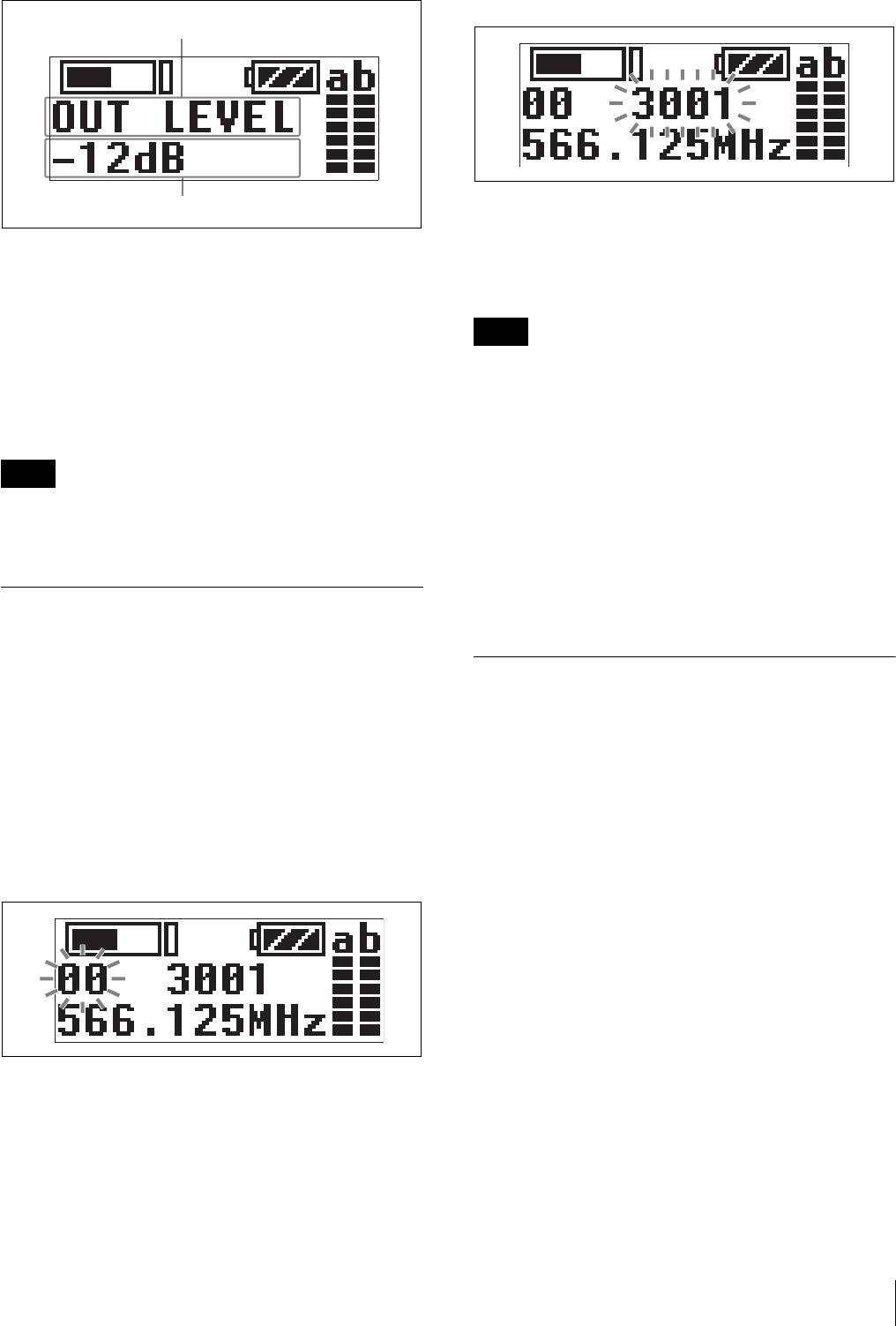
Tuner Settings 21
Basic menu operation
The basic menu operation is the same in simple mode and
extended mode.
1
Press the + or – button to display the function to be
set.
2
Press and hold the SET button until the setting starts
flashing.
3
Press the + or – button to change the setting.
4
Press the SET button to enter the setting.
If no operation is performed for five seconds, the
backlight will turn off. Pressing any button will turn the
backlight on again.
Setting the receive channel
Procedure for portable diversity tuner (URX-P03)
For details about the channel groups and channels that can
be selected, refer to the “Frequency List” on the
CD-ROM.
1
Use the + or – button to display the GP/CH menu.
2
Press and hold the SET button for one second or
longer.
The channel group display starts flashing.
3
Use the + or – button to select the desired group
name, then press the SET button.
The channel group is set, and the channel number
display starts flashing.
4
Use the + or – button to select the desired channel
number, then press the SET button.
The displays stops flashing and the desired channel is
set.
• If there is no user input within ten seconds after the
channel group display or channel number display starts
flashing, the displayed setting that is flashing is saved.
The same applies when setting other parameters.
• The frequency indicator changes in response to the
channel number.
• The tuner continues to receive, even when setting the
receive channel.
• Do not remove the batteries while setting the receive
channel. If they are removed, re-insert them and repeat
the procedure from the beginning.
• Make sure that the same channel is set on the
transmitter and tuner within the same system.
Searching for available channels
within a group (Clear Channel Scan)
Procedure for portable diversity tuner (URX-P03)
You can search for available channels within the
specified channel group.
Before performing this procedure, select the channel
group.
For details, see “Setting the receive channel” (page 21).
1
Use the + or – button to display the CLR SCAN
menu.
2
Press and hold the SET button for one second or
longer.
Press and hold until the channel group and “+”
display starts flashing.
Note
Function name
Setting
Notes
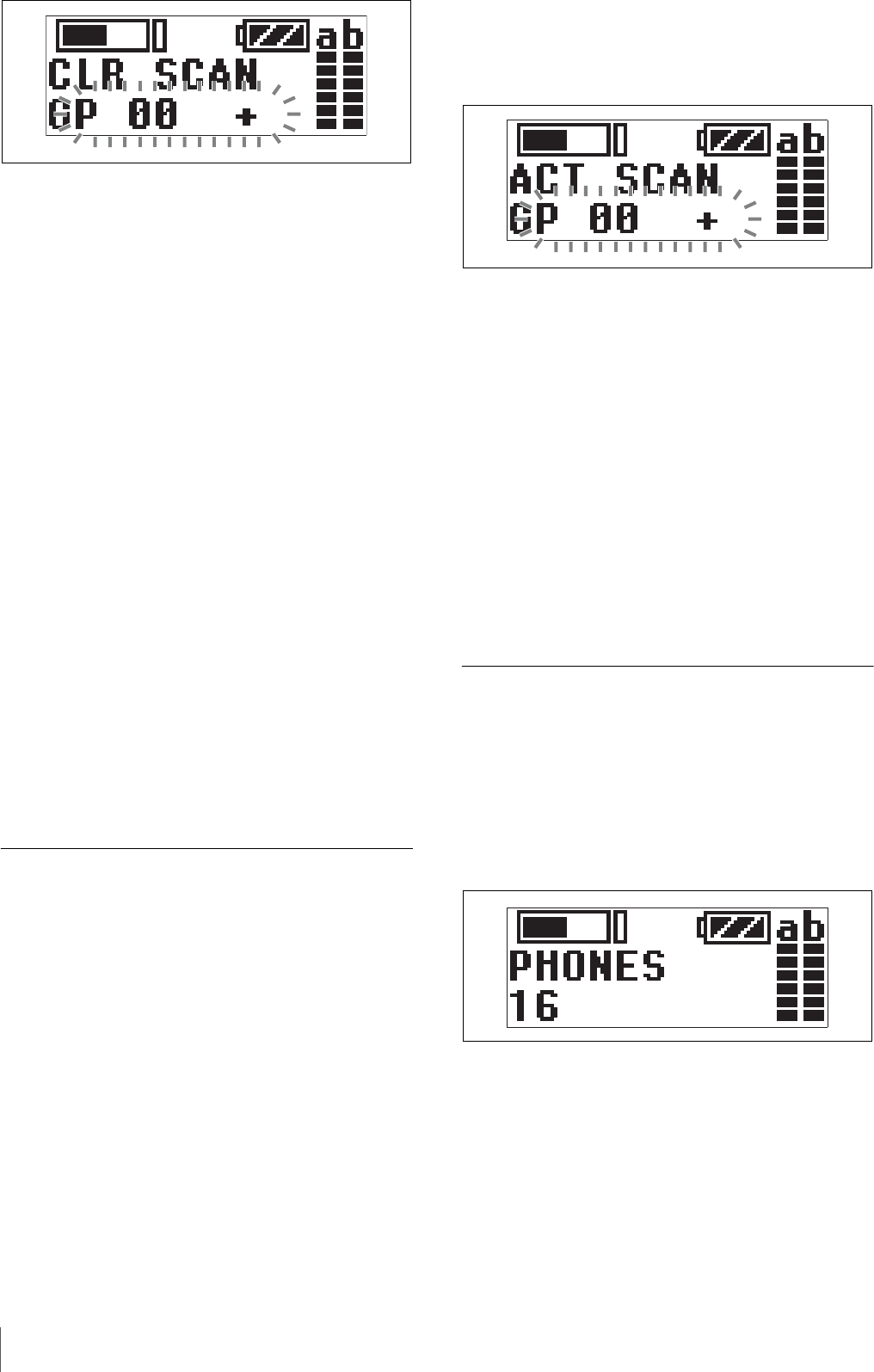
Tuner Settings
22
3
Press the + button.
The tuner starts to scan through the selected channel
group. When available channels are found, the first
channel number among the available channels starts
flashing on the display.
To display the next available channel number
Press the + button.
To cancel searching
Press the – button. The display returns to the CLR
SCAN menu.
4
Press the SET button when the desired channel
number starts flashing.
The search for available channels finishes and the
displayed channel is set.
The channel setting is transmitted from the infrared
transmission port for about ten seconds after setting
the channel. During this interval, place the infrared
detector on the transmitter (with the power turned on)
near the tuner to transfer the channel setting from the
tuner to the transmitter.
To scan channels automatically when
power is turned on
With the tuner power off, press and hold the SET button
and press the POWER button for at least one second to
turn the power on and to automatically start a clear
channel scan.
Searching for active channels
within a group (Active Channel
Scan)
Procedure for portable diversity tuner (URX-P03)
You can search for channels in use within the specified
channel group. This is useful when using more than one
tuner in combination with a single transmitter.
Before performing this procedure, select the channel
group.
For details, see “Setting the receive channel” (page 21).
1
Use the + or – button to display the ACT SCAN
menu.
2
Press and hold the SET button for one second or
longer.
Press and hold until the channel group and “+”
display starts flashing.
3
Press the + button.
The tuner starts to scan for active channels in the
selected channel group. When active channels are
found, the first channel number among the active
channels starts flashing on the display.
To display the next active channel number
Press the + button.
To cancel searching
Press the – button. The display returns to the ACT
SCAN menu.
4
Press the SET button when the desired channel
number starts flashing.
The search for active channels finishes and the
displayed channel is set.
Adjusting the monitor audio level
Procedure for portable diversity tuner (URX-P03)
You can set the monitor audio level within the range 1 to
16.
1
Use the + or – button to display the PHONES menu.
The current monitor audio level is displayed.
2
Press and hold the SET button for at least one second.
Press and hold until the monitor audio level flashes.
3
Use the + or – button to set the desired monitor audio
level, then press the SET button.
The setting value is stored. The setting is retained
even after the power is turned off.

Tuner Settings 23
Configuration menu
Procedure for portable diversity tuner (URX-P03)
This section describes each function and configurable
items.
Underlined entries are factory default values.
Selecting group/channel (GP/CH)
The factory default setting varies depending on the
model.
For details, see “Setting the receive channel” (page 21).
Adjusting the monitor audio level
(PHONES)
Adjusts the monitor audio level for the headphones.
The factory default setting is 12.
For details, see “Adjusting the monitor audio level”
(page 22).
Setting an available channel automatically
(AUTO SET)
Automatically searches for and sets an available channel,
and starts infrared transmission to the transmitter.
For details, see “Operation” (page 19).
Selecting the frequency band (BAND)
Selects the receive frequency band.
This menu is not available on Japanese and Korean
models. On these models, the frequency band cannot be
selected.
For details about the groups and channels in each
frequency band, refer to the “Frequency List” on the
CD-ROM.
Searching for and selecting available
channels (CLR SCAN)
Searches for available channels.
For details, see “Searching for available channels within
a group (Clear Channel Scan)” (page 21).
Setting the audio output level (OUT
LEVEL)
Sets the audio output level. You can set the level in 3 dB
increments in the range –12 dB to +12 dB. The factory
default setting is 0 dB.
The monitor output level does not change when you
change the output level in the OUT LEVEL menu. The
monitor output level is adjusted separately.
For details about adjusting the monitor audio level, see
“Adjusting the monitor audio level” (page 22).
Using infrared transmission (SYNC)
Transfers the frequency and compander mode set on the
tuner to a transmitter using an infrared transmitter.
1
Use the + or – button to display the SYNC menu.
2
Press and hold the SET button for one second or
longer.
A confirmation screen appears.
3
Use the + or – button to display “YES.”
4
Turn the transmitter power on, and place the infrared
transmitter port on the tuner near the infrared detector
on the transmitter.
A prompt appears on the transmitter display asking
you whether to change the frequency.
5
Use the + or – button on the transmitter to select YES.
6
Press the SET button on the transmitter.
The frequency and compander mode for use on the
transmitter are set.
• When using the infrared link, place the tuner and
transmitter within about 20 cm (8 in.) of each other.
• After the infrared transmission starts, place the tuner
near the transmitter within ten seconds. After ten
seconds have elapsed, the infrared transmission finishes
and the display returns to the previous menu.
• After the prompt appears on the transmitter, you can
select NO or do nothing for about five seconds to return
to the previous menu screen automatically, and the
information received over the infrared link is discarded.
Displaying the accumulated running time
(TIME)
Displays the accumulated running time of the tuner as a
guide to total usage time.
The factory default setting is 00:00. Up to 99:99 can be
displayed.
To reset the time display
1
Press and hold the SET button until the time display
starts flashing.
Note
Note
Notes

Tuner Settings
24
2
Press the – button to display “00:00 CLR” and press
the SET button.
Pressing the + button when “00:00 CLR” is displayed
causes the time display to start flashing. You can
press the SET button in this state to cancel the reset of
the accumulated running time.
Setting the menu display mode (MENU
MODE)
Sets the menu display mode.
SIMPLE: Displays only the required settings.
ADVANCED: Displays all settings.
Setting the compander mode
(COMPANDER)
Sets the operating mode of the compander.
UWP-D: High speech quality mode supported in
combination with UWP-D series devices.
UWP: Mode supported in combination with Sony UWP-
series transmitters.
WL800: Mode supported in combination with Sony 800-
series transmitters.
• This function is displayed in extended mode only.
• No audio is output if the tone signal frequency is
different due to the use of a combination of devices with
different compander mode settings.
Selecting the preferred power supply
(PWR SOURCE)
Specifies whether the power supply from the batteries
inserted in the unit or from an external USB portable
power supply or accessory connected to the USB
connector or auxiliary connector has precedence.
BATT -> EXT: Batteries inserted in the unit have
precedence.
EXT -> BATT: Power supplied from a USB connector or
externally connected sources have precedence.
BATT ONLY: Batteries inserted in the unit are used, and
power supplied from the USB connector or auxiliary
connector is not used even after the batteries are
discharged.
When BATT -> EXT or EXT -> BATT is specified and
power from the preferred source is cut off, the power
supply automatically switches to the other source.
Therefore, when only one power supply is available, that
power supply will be used regardless of the PWR
SOURCE setting. There may be a brief interruption in the
audio when the power supply switches.
Setting the frequency to an active channel
(ACT SCAN)
Searches for channels already in use. This is useful when
using more than one tuner in combination with a single
transmitter.
This function is displayed in extended mode only.
For details, see “Searching for active channels within a
group (Active Channel Scan)” (page 22).
Locking the POWER button (PWR LOCK)
You can lock the POWER button to prevent the power
being turned off inadvertently during reception.
UNLOCK: Press and hold the POWER button to turn the
power on/off.
LOCK: The power does not turn off, even after pressing
the POWER button.
To release the lock state
To release the lock state, either set the PWR LOCK menu
to UNLOCK or use the following procedure.
1
When the button is in the LOCK state, press and hold
the POWER button.
A prompt appears asking you whether to release the
lock state.
2
Use the + or – button to select YES, then press the
SET button.
The lock state is released.
• This function is displayed in extended mode only.
• The POWER button lock state does not change after
switching to simple mode after setting the button to
LOCK in extended mode.
• If the batteries are removed and reinserted while the
POWER button is set to LOCK, the power will turn on
automatically but the lock state of the POWER button
does not change.
Setting the battery type (BATTERY)
You can set the type of battery being used in order to
provide a more accurate battery level indication.
TYPE1: Recommended setting when using alkaline LR6
(size AA) batteries. Indicates the battery level based on
the characteristics of new Sony alkaline LR6 (size AA)
batteries.
TYPE2: Recommended setting when using rechargeable
nickel metal hydride batteries.
TYPE3: Recommended setting when using lithium
batteries.
Notes
Note
Note
Notes

Transmitter Settings 25
• This function is displayed in extended mode only.
• The characteristics of batteries change according to
battery type and environmental conditions. It is
recommended that you understand the characteristics of
batteries before using them.
Setting the display contrast (CONTRAST)
You can adjust the contrast of text and icons on the
display in the range 1 to 10.
The configurable values are given below.
(Light) 1 2 3 4 5 6 7 8 9 10 (Dark)
This function is displayed in extended mode only.
Restoring factory default settings
(RESET)
Restores all parameters to their factory default settings.
Press and hold the SET button. A prompt appears asking
you whether to restore factory default settings. Press the
+ or – button to select YES, then press the SET button.
The tuner parameters are restored to their factory default
settings.
• This function is displayed in extended mode only.
• After a reset, the audio output level and monitor output
level are also restored to their factory default settings.
Note that this may cause the volume on connected
devices and in headphones to suddenly change.
Displaying the software version
(VERSION)
Displays the software version of the tuner.
This function is displayed in extended mode only.
Transmitter Settings
Menu structure and operation
Procedure for all transmitters (UTX-B03/M03/
P03)
There are three menu display modes that can be selected
according to the application.
Simple mode
This mode displays only the required settings for
transmitting audio.
You can enable simple mode by setting MENU MODE
(menu display mode) to SIMPLE.
Configuration menus
• GP/CH (group/channel) select
• BAND (frequency band) select (Not available on
Japanese and Korean models)
• RF POWER (RF transmit output level) select
• ATT (attenuator) setting
• LCF (low-cut filter) setting
• IN LEVEL (audio input level) select (UTX-B03/P03
only)
• +48V (+48 V supply) setting (UTX-P03 only)
• TIME (accumulated running time) display
• MENU MODE (menu display mode) setting
The following configuration menus cannot be modified
during transmission. Set these menus in transmission
stopped mode.
• GP/CH (group/channel) select
The following configuration menus do not appear and
cannot be modified during transmission. Set these menus
in transmission stopped mode.
• BAND (frequency band) select (Not available on
Japanese and Korean models)
• RF POWER (RF transmit output level) select
Extended mode
This mode displays all configuration menus.
You can enable extended mode by setting MENU MODE
(menu display mode) to ADVANCED.
The existing settings configured in extended mode are
active even when using simple mode.
Configuration menus
• GP/CH (group/channel) select
• BAND (frequency band) select (Not available on
Japanese and Korean models)
• RF POWER (RF transmit output level) select
• ATT (attenuator) setting
• LCF (low-cut filter) setting
Notes
Note
Notes
Note
Notes
Note

Transmitter Settings
26
• IN LEVEL (audio input level) select (UTX-B03/P03
only)
• +48V (+48 V supply) setting (UTX-P03 only)
• TIME (accumulated running time) display
• MENU MODE (menu display mode) setting
• COMPANDER (compander mode) setting
• PWR LOCK (POWER button lock) function
• MUTING (muting function) setting
• PHASE (phase switching) setting (UTX-B03 only)
• BATTERY (battery type) setting
• CONTRAST (display text contrast) setting
• RESET (factory default setting) function
• VERSION (software version) display
The following configuration menus cannot be modified
during transmission. Set these menus in transmission
stopped mode.
• GP/CH (group/channel) select
The following configuration menus do not appear and
cannot be modified during transmission. Set these menus
in transmission stopped mode.
• BAND (frequency band) select (Not available on
Japanese and Korean models)
• RF POWER (RF transmit output level) select
• RESET (factory default setting) function
Transmission stopped mode
This mode allows settings to be modified when RF
transmission has stopped.
Use this mode to make settings without risk of
interrupting other wireless traffic when setting channels
and other settings.
With the power off, press and hold the SET button and
press the POWER/MUTING button for at least one
second to turn the power on and to display the
transmission stopped mode menu.
The following configuration menus can only be modified
in transmission stopped mode.
• GP/CH (group/channel) select
• BAND (frequency band) select (Not available on
Japanese and Korean models)
• RF POWER (RF transmit output level) select
• RESET (factory default setting) function
Basic menu operation
The basic menu operation is the same in simple mode,
extended mode, and transmission stopped mode.
1
Press the + or – button to display the function to be
set.
2
Press and hold the SET button until the setting starts
flashing.
3
Press the + or – button to change the setting.
4
Press the SET button to enter the setting.
If no operation is performed for five seconds, the
backlight will turn off. Pressing any button will turn the
backlight on again.
Setting the transmit channel
Procedure for all transmitters (UTX-B03/M03/
P03)
For details about the channel groups and channels that can
be selected, refer to the “Frequency List” on the
CD-ROM.
1
Press and hold the SET button and press the POWER/
MUTING button to turn the power on.
2
Use the + or – button to display the GP/CH menu.
3
Press and hold the SET button for one second or
longer.
Press and hold until the channel group display starts
flashing.
4
Use the + or – button to select the desired group
name, then press the SET button.
The channel group is set, and the channel number
display starts flashing.
Note
Function name
Setting
Note

Transmitter Settings 27
5
Use the + or – button to select the desired channel
number, then press the SET button.
The displays stops flashing and the desired channel is
set.
• If there is no user input within ten seconds after the
channel group display or channel number display starts
flashing, the displayed setting that is flashing is saved.
The same applies when setting other parameters.
• The frequency indicator changes in response to the
channel number.
• Do not remove the batteries while making settings. If
they are removed, re-insert them and repeat the
procedure from the beginning.
• Make sure that the same channel is set on the
transmitter and tuner within the same system.
Configuration menu
Procedure for all transmitters (UTX-B03/M03/
P03)
This section describes each function and configurable
items.
Underlined entries indicate factory default settings.
Selecting group/channel (GP/CH)
The factory default setting varies depending on the
model.
For details, see “Setting the transmit channel” (page 26).
This function can be modified in transmission stopped
mode only.
Selecting the frequency band (BAND)
Selects the transmit frequency band.
• This function can be modified in transmission stopped
mode only.
• This menu is not available on Japanese and Korean
models. On these models, the frequency band cannot be
selected.
For details about the groups and channels in each
frequency band, refer to the “Frequency List” on the
CD-ROM.
Setting the transmit output level (RF
POWER)
Set the transmitted RF power to HIGH or LOW. The
transmit power level varies depending on the model.
This function can be modified in transmission stopped
mode only.
Adjusting the audio input attenuation
level (ATT)
You can set the audio input attenuation level in 3 dB
increments to reduce noise distortion.
The factory default setting is 9 dB (UTX-B03) or 0 dB
(UTX-M03 and UTX-P03).
• On the UTX-B03/P03, “---” is displayed if IN LEVEL
is set to LINE, and the attenuation level cannot be
modified (fixed at 0 dB).
• If the attenuation level is set too high, the noise level
may increase. Set the level as close as possible to 0 dB
if using a lavalier microphone attached to your torso.
Setting the low-cut filter (LCF)
You can set the low-cut filter to reduce noise caused by
wind.
You can set the cutoff frequency to OFF/LOW/MID/
HIGH.
OFF: No filtering
LOW: 100 Hz cutoff frequency
MID: 150 Hz cutoff frequency
HIGH: 200 Hz cutoff frequency
Switching the audio input level (IN LEVEL)
(UTX-B03/P03 only)
Sets the input level according to the audio input device.
You can switch between MIC and LINE. The factory
default setting is MIC.
Do not switch this function to “MIC” when the audio
input source is an audio mixer or other line level device.
If an excessive audio level is input, it may cause noise
distortion or damage the playback/recording equipment.
Setting the microphone drive power
supply (+48V) (UTX-P03 only)
You can supply power from the transmitter when using a
microphone that requires an external power supply.
When set to ON, power is supplied to the connected
microphone and the +48 V indicator starts flashing.
The factory default setting is OFF.
Displaying the accumulated running time
(TIME)
Displays the accumulated running time of the transmitter
as a guide to total usage time.
The factory default setting is 00:00. Up to 99:99 can be
displayed.
Notes
Note
Notes
Note
Notes
Note

Transmitter Settings
28
To reset the time display
1
Press and hold the SET button until the time display
starts flashing.
2
Press the – button to display “00:00 CLR” and press
the SET button.
Pressing the + button when “00:00 CLR” is displayed
causes the time display to start flashing. You can
press the SET button in this state to cancel the reset of
the accumulated running time.
Setting the menu display mode (MENU
MODE)
Sets the menu display mode.
SIMPLE: Displays only the required settings.
ADVANCED: Displays all settings.
Setting the compander mode
(COMPANDER)
Sets the operating mode of the compander.
UWP-D: High speech quality mode supported in
combination with UWP-D series devices.
UWP: Mode supported in combination with Sony UWP-
series tuners.
WL800: Mode supported in combination with Sony 800-
series tuners.
• This function is displayed in extended mode only.
• No audio is output if the tone signal frequency is
different due to the use of a combination of devices with
different compander mode settings.
Locking the POWER/MUTING button
(PWR LOCK)
You can lock the POWER/MUTING button to prevent
the power being turned off inadvertently during
transmission.
UNLOCK: Press and hold the POWER/MUTING button
to turn the power on/off.
LOCK: The power does not turn off, even after pressing
the POWER/MUTING button.
To release the lock state
To release the lock state, either set the PWR LOCK menu
to UNLOCK or use the following procedure.
1
When the button is in the LOCK state, press and hold
the POWER/MUTING button.
A prompt appears asking you whether to release the
lock state.
2
Use the + or – button to select YES, then press the
SET button.
The lock state is released.
• This function is displayed in extended mode only.
• The POWER/MUTING button lock state does not
change after switching to simple mode after setting the
button to LOCK in extended mode.
• If the batteries are removed and reinserted while the
POWER/MUTING button is set to LOCK, the power
will turn on automatically but the lock state of the
POWER/MUTING button does not change.
Muting the output (MUTING)
Pressing the POWER/MUTING button while
transmitting mutes the audio so that audio from the tuner
is not output. Pressing the POWER/MUTING button
again restores the audio output.
ENABLE: Pressing the POWER/MUTING button mutes
the output.
DISABLE: The output is not muted even when the
POWER/MUTING button is pressed.
• This function is displayed in extended mode only.
• In muting, the audio signal is not output but an RF
signal is still transmitted.
Switching the phase of the microphone
(PHASE) (UTX-B03 only)
You can switch the phase of a connected microphone
(excluding the supplied lavalier microphone) to output
audio in reverse phase.
NORMAL: Phase is not reversed. Set to NORMAL
when the supplied lavalier microphone is connected.
INVERT: Reverses the phase within the transmitter.
This function is displayed in extended mode only.
Setting the battery type (BATTERY)
You can set the type of battery being used in order to
provide a more accurate battery level indication.
TYPE1: Recommended setting when using alkaline LR6
(size AA) batteries. Indicates the battery level based on
the characteristics of new Sony alkaline LR6 (size AA)
batteries.
TYPE2: Recommended setting when using rechargeable
nickel metal hydride batteries.
TYPE3: Recommended setting when using lithium
batteries.
• This function is displayed in extended mode only.
• The characteristics of batteries change according to
battery type and environmental conditions. It is
recommended that you understand the characteristics of
batteries before using them.
Notes
Notes
Notes
Note
Notes

Transmitter Settings 29
Setting the display contrast (CONTRAST)
You can adjust the contrast of text and icons on the
display in the range 1 to 10.
The configurable values are given below.
(Light) 1 2 3 4 5 6 7 8 9 10 (Dark)
This function is displayed in extended mode only.
Restoring factory default settings
(RESET)
Restores all parameters to their factory default settings.
Press and hold the SET button. A prompt appears asking
you whether to restore factory default settings. Press the
+ or – button to select YES, then press the SET button.
The transmitter parameters are restored to their factory
default settings.
• This function can be used in transmission stopped mode
only.
• After a reset, the audio input level is also restored to its
factory default setting. Note that this may cause the
volume on devices connected to the tuner and in
headphones to suddenly change.
Displaying the software version
(VERSION)
Displays the software version of the transmitter.
This function is displayed in extended mode only.
Note
Notes
Note
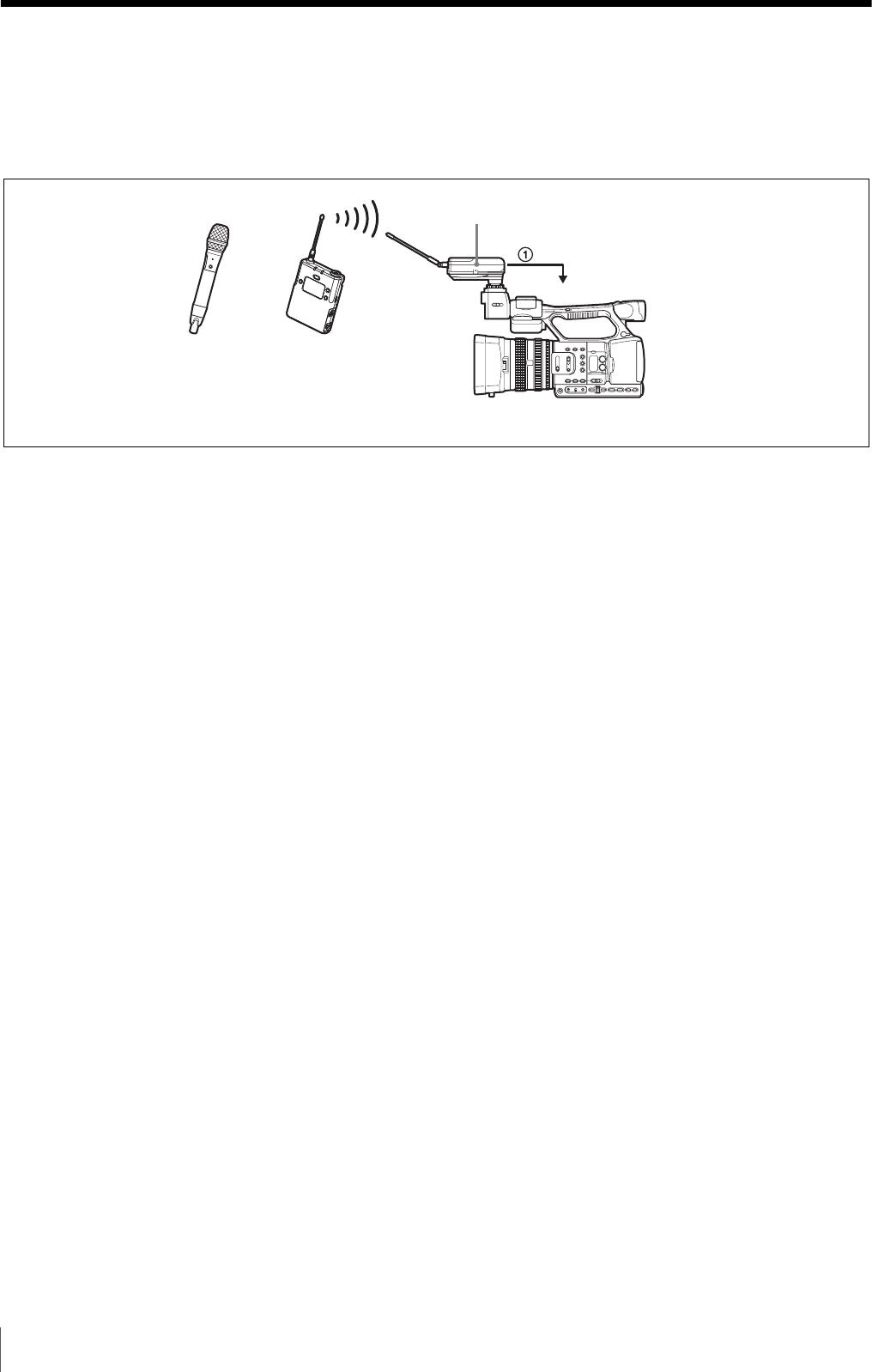
System Configuration Examples
30
System Configuration Examples
The following are configuration examples for use with UWP-D series devices.
Sample configuration for ENG (Electronic News Gathering) or EFP (Electronic Field Production) with a
camcorder
Portable diversity tuner (URX-P03)
(with shoe mount adapter attached)
Body-pack
transmitter
(UTX-B03)
XDCAM EX/HDV camcorder
(HXR-NX3, etc.)
or
1 XLR-BMP conversion output cable (supplied)
Hand-held
microphone
(UTX-M03)

Error Messages 31
Error Messages
When a problem occurs, one of the following error messages may appear on the display.
Message Meaning Solution
EEP ERROR An error has occurred in the backup memory data. Contact your point of purchase or Sony service
representative.
PLL ERROR An error occurred in the PLL synthesizer circuit. Restart the unit. If the message persists, contact your
point of purchase or Sony service representative.
NO TONE Audio signal output has been muted, because a tone
signal different from the compander mode configured
on the tuner was received.
Configure the appropriate compander mode based on
the transmitters you are using “Setting the compander
mode (COMPANDER)” (page 24).
When operating in conjunction with UWP-D series
transmitters (UTX-B03, UTX-M03, etc.), set the tuner
and the transmitters to the same compander mode.

Troubleshooting
32
Troubleshooting
If you have any problem, use the following checklist before asking for repairs. If the problem persists, contact your point
of purchase or Sony service representative.
Symptom Cause Solution
The unit does not turn
on.
The 3 and # polarity orientation of the batteries is
incorrect.
Insert the batteries with the correct polarity
orientation.
The batteries are getting low. Replace the batteries with new ones.
The battery terminals are dirty. Clean the 3 and # terminals with a cotton swab.
Batteries are not inserted despite PWR SOURCE
being set to BATT ONLY.3)
Insert batteries, or change the PWR SOURCE
setting.
The unit does not turn
off.
The POWER/MUTING button is locked. Release the locked status in the PWR LOCK
menu.
The batteries become
drained quickly.
The batteries are getting low. Replace the batteries with new ones.
Manganese batteries are being used. Use alkaline batteries. The battery life of a
manganese battery is less than half that of an
alkaline battery.
The device is being used under cold conditions. The batteries drain quickly under cold conditions.
The channel cannot
be changed.1)
The unit is not in transmission stopped mode. Turn off the unit, and then turn it on again while
holding down the SET button to switch to
transmission stopped mode.
There is no sound. The channel setting on the transmitter is different
from that on the tuner.
Use the same channel setting on both the
transmitter and tuner.
The transmitter is not transmitting signals, or the
transmission output is weak.
Confirm that the transmitter is turned on.
Alternatively, reduce the distance between the
transmitter and tuner.
The transmitter is set to line level input.2) Switch to microphone input.
The compander mode setting on the transmitter is
different from that on the tuner.
Use the same compander mode setting on both
the transmitter and tuner.
The transmitter is muted.2) Press the POWER/MUTING button on the
transmitter to release the muted state.
The sound is weak. The attenuation level on the transmitter is too high. The input level of the transmitter is low. Set the
attenuation of the transmitter to an appropriate
level.
The volume on the amplifier or mixer is low. Adjust the volume to an appropriate level.
The transmitter is set to line level input.2) Switch to microphone input.
The compander mode setting on the transmitter is
different from that on the tuner.
Use the same compander mode setting on both
the transmitter and tuner.
The sound is
distorted.
The attenuation level on the transmitter is too low
or is set to 0.
The input level is extremely high. Set the
attenuation on the transmitter so that the audio is
not distorted.
The channel setting on the transmitter is different
from that on the tuner.
Use the same channel setting on both the
transmitter and tuner.
Headphones with a monaural mini jack are being
used.3)
Use headphones with a stereo mini jack.

Troubleshooting 33
1) Body-pack transmitter (UTX-B03) / hand-held microphone (UTX-M03) / plug-on transmitter (UTX-P03) only
2) Body-pack transmitter (UTX-B03) / plug-on transmitter (UTX-P03) only
3) Portable diversity tuner (URX-P03) only
There is sound
interruption or noise.
The channel setting on the transmitter is different
from that on the tuner.
Use the same channel setting on both the
transmitter and tuner.
Two or more transmitters are set to the same
channel.
Two or more transmitters cannot be used on the
same channel. Refer to the frequency list stored
on the supplied CD-ROM, and reconfigure the
channel on each transmitter.
The transmitters are not set to the channels within
the same channel group.
The channel plan is set so that no signal
interference occurs when two or more transmitters
are used simultaneously. Set each transmitter to a
different channel within the same channel group.
Adjacent channels are being used. Use the channels separated by at least two
channels (250 kHz).
The RF indicator on
the tuner lights up
even when the
transmitter is off.
Jamming radio waves are being received. Set the channel on the tuner to a channel for which
the RF indicator does not light, or use the Clear
Channel Scan function to switch to a channel
without interference. Then, set the transmitter to
the same channel as the tuner.
If using two or more transmitters, change to a
channel group that is not affected.
The transmitter
channel cannot be set
with infrared
transmission.
The infrared receptor on the transmitter is too far
from the infrared transmission port on the tuner.
Reduce the distance between the infrared receptor
on the transmitter and the infrared transmission
port on the tuner to within about 20 cm (8 in.).
Interference from infrared communications
between other devices or from direct sunlight is
present.
The transmitting distance is reduced when
interference from strong sunlight, for example, is
present. Place the transmitter and tuner as close
to each other as possible.
Symptom Cause Solution

34 Important Notes on Use / Specifications
Important Notes on Use
Usage and storage
• Operating the UWP-D series devices near electrical
equipment (motors, transformers, or dimmers) may
cause interference due to electromagnetic induction.
Keep the devices as far from such equipment as
possible.
• The presence of lighting equipment may produce
electrical interference over a wide frequency range. In
this case, interference may fluctuate with the position of
the tuner antenna and position of the transmitter.
Position the devices so that interference is minimized.
• To avoid degradation of the signal to noise ratio, do not
use UWP-D devices in noisy places or in locations
subject to vibration, such as the following:
– Near electrical equipment, such as motors,
transformers, or dimmers
– Near air conditioning equipment or places subject to
direct air flow from an air conditioner
– Near PA (public address) loudspeakers
– Near equipment that might knock against the tuner
Keep devices as far from such equipment as possible or
use buffering material.
Cleaning
Clean the surface and the connectors of devices with a
dry, soft cloth. Never use thinners, benzene, alcohol, or
any other chemicals, since these may mar the finish.
Specifications
Design and specifications are subject to change without
notice.
Transmitter (UTX-B03/M03/P03)
Items common to all transmitters
Oscillator type Crystal-controlled PLL synthesizer
Carrier frequencies
Models available in USA:
470 MHz to 542 MHz (UC14 model),
566 MHz to 608 MHz and 614 MHz
to 638 MHz (UC30 model),
638 MHz to 698 MHz (UC42 model),
941.625 MHz to 951.875 MHz and
953.000 MHz to 956.125 MHz and
956.625 MHz to 959.625 MHz
(UC90 model)
Models available in Europe:
470 MHz to 542 MHz (CE21 model),
566 MHz to 630 MHz (CE33 model),
638 MHz to 694 MHz (CE42 model),
710 MHz to 782 MHz (CE51 model)
Model available in China:
710 MHz to 782 MHz (CN38 model)
Model available in Korea:
925 MHz to 937.5 MHz (KR Model)
Model available in Thailand and
Taiwan:
794 MHz to 806 MHz (E model)
Preemphasis 50 μs
Reference deviation
±5 kHz (–60 dBV, 1 kHz input)
Distortion 0.9% or less (–60 dBV, 1 kHz input)
Signal-to-noise-ratio
60 dB or more
Voice delay 0.35 ms
To prevent electromagnetic interference
Some channels may be unable to be used due to noise
generated due to the effects of external noise and/or
radio interference. In this case, it is recommended to
stop transmitting (turn the power off) or change to
another frequency (change channel).
To prevent electromagnetic interference from
portable communication devices
The use of portable telephones and other
communication devices near the devices may result in
malfunction and interference with audio signals. It is
recommended that portable communication equipment
near the devices be turned off.
Notes
• Always verify that the unit is operating properly
before use. SONY WILL NOT BE LIABLE FOR
DAMAGES OF ANY KIND INCLUDING, BUT
NOT LIMITED TO, COMPENSATION OR
REIMBURSEMENT ON ACCOUNT OF THE
LOSS OF PRESENT OR PROSPECTIVE PROFITS
DUE TO FAILURE OF THIS UNIT, EITHER
DURING THE WARRANTY PERIOD OR AFTER
EXPIRATION OF THE WARRANTY, OR FOR
ANY OTHER REASON WHATSOEVER.
• SONY WILL NOT BE LIABLE FOR CLAIMS OF
ANY KIND MADE BY USERS OF THIS UNIT OR
MADE BY THIRD PARTIES.
• SONY WILL NOT BE LIABLE FOR THE
TERMINATION OR DISCONTINUATION OF
ANY SERVICES RELATED TO THIS UNIT THAT
MAY RESULT DUE TO CIRCUMSTANCES OF
ANY KIND.
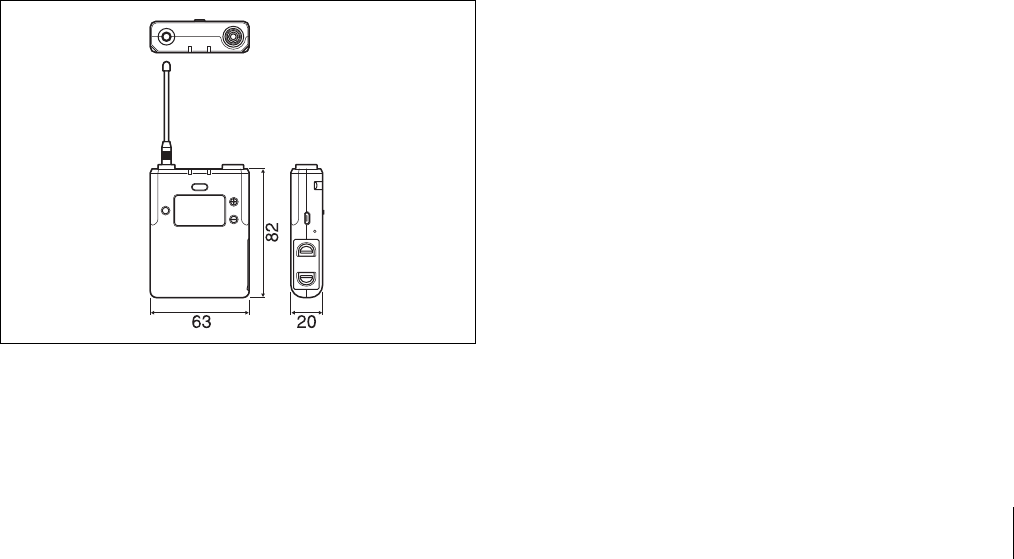
Specifications 35
Tone signal frequency
In UWP-D compander mode:
32.382 kHz
In UWP compander mode: 32 kHz
In WL800 compander mode:
32.768 kHz
Supply voltage 3.0 V DC (two LR6/AA size alkaline
batteries)
5.0 V DC (supplied from USB
connector)
Operating temperature
0 °C to 50 °C (32 °F to 122 °F)
0 °C to 35 °C (32 °F to 95 °F) when
charging
Storage temperature
–20 °C to +55 °C (–4 °F to +131 °F)
Body-pack transmitter (UTX-B03)
Antenna 1/4 λ wavelength wire antenna
Audio input connector
3.5 mm diameter mini jack
Reference audio input level
–60 dBV (MIC input, 0 dB attenuation)
RF output level 30 mW/5 mW selectable (for model
available in USA, Europe, and
China)
10 mW/2 mW selectable (for model
available in Thailand, Taiwan, and
Korea)
Frequency response
40 Hz to 18 kHz
Attenuation 0 dB to 27 dB (3 dB steps)
Indicators AUDIO, POWER/MUTING
Battery life (measured with two Sony LR6/AA size
alkaline batteries at 25 °C (77 °F))
Approx. 8 hours with output power of
30 mW (for model available in USA,
Europe, and China)
Approx. 10 hours with output power of
10 mW (for model available in
Thailand, Taiwan, and Korea)
Dimensions
63 × 82 × 20 mm (2 1/2 × 3 1/4 × 13/16 in.)
(Width / height / depth)
(excluding antenna)
Mass Approx. 103 g (3.6 oz)
(excluding batteries)
Lavalier microphone (ECM-V1BMP)
Type Electret condenser microphone
Frequency response
40 Hz to 20,000 Hz
Directivity Omni-directional
Sensitivity –43.0 ±3 dB (0 dB =1 V/Pa, at 1 kHz)
Operating temperature
0°C to 50°C (32°F to 122°F)
Storage temperature
–20°C to +55°C (–4°F to +131°F)
Cable 2.3 mm dia., 2-conductor shielded cable,
1.2 m (3.9 feet) long
Dimensions φ 6.8 × 19.5 mm (9/32 × 25/32 in.)
(without cable and connector)
Mass Approx. 16.2 g (0.57 oz)
Hand-held microphone (UTX-M03)
Microphone unit
Dynamic
Directional characteristic
Unidirectional
Antenna 1/4 λ wavelength wire antenna
Reference audio input level
–55 dBV (MIC input, 0 dB attenuation)
RF output level 30 mW/5 mW selectable (for model
available in USA, Europe, and
China)
10 mW/2 mW selectable (for model
available in Thailand, Taiwan, and
Korea)
Frequency response
70 Hz to 18 kHz
Attenuation 0 dB to 21 dB (3 dB steps)
Indicator POWER/MUTING
Battery life (measured with two Sony LR6/AA size
alkaline batteries at 25 °C (77 °F))
Approx. 8 hours with output power of
30 mW (for model available in USA,
Europe, and China)
Approx. 10 hours with output power of
10 mW (for model available in
Thailand, Taiwan, and Korea)
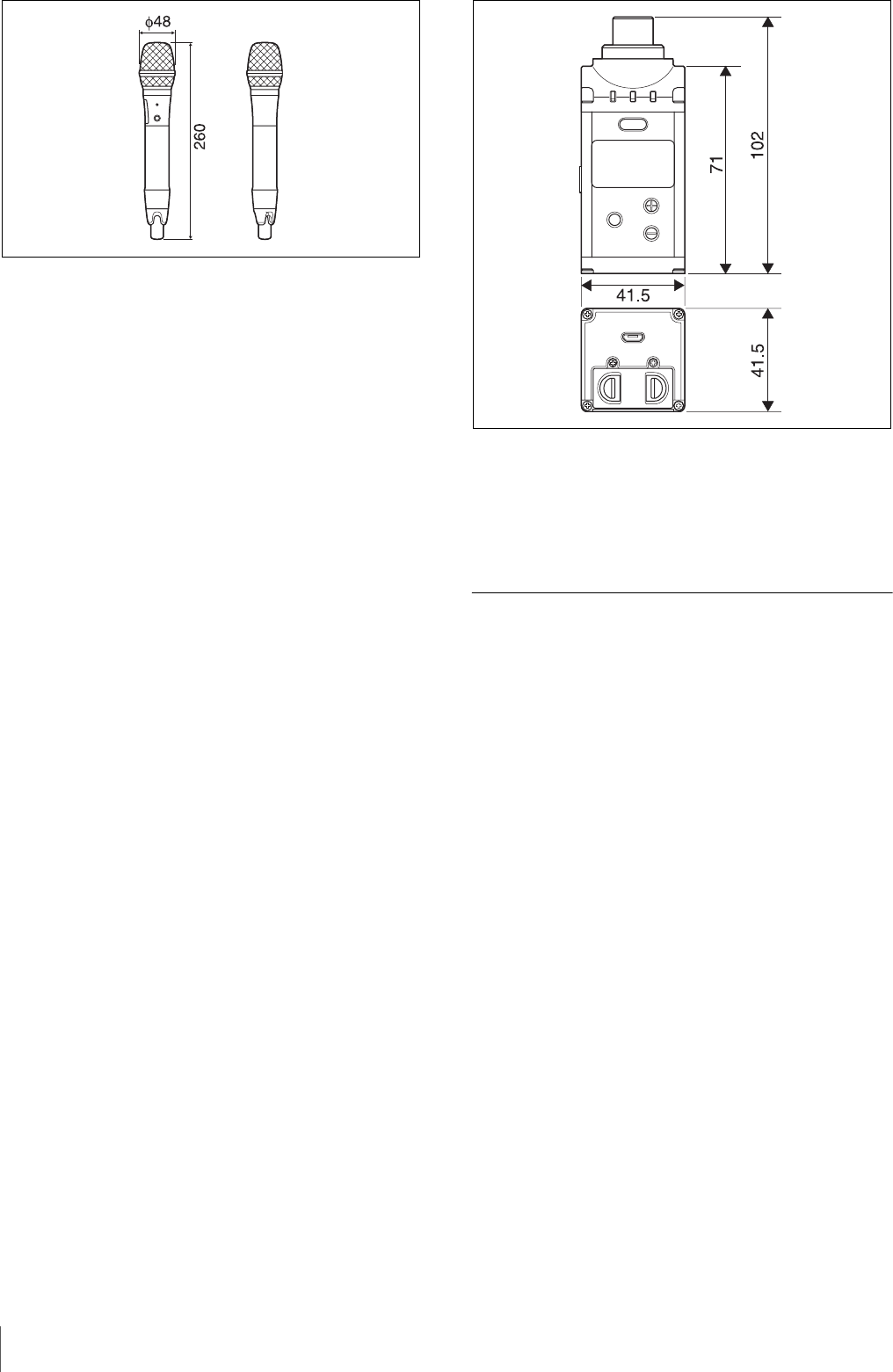
Specifications
36
Dimensions
φ 48 × 260 mm (1 15/16 × 10 1/4 in.)
(Diameter / length)
Mass Approx. 260 g (9.2 oz)
(excluding batteries)
Plug-on transmitter (UTX-P03)
Reference audio input level
–60 dBV (at 0 dB attenuation level)
RF output level
40 mW/5 mW selectable (for model
available in USA)
30 mW/5 mW selectable (for model
available in Europe, and China)
10 mW/2 mW selectable (for model
available in Thailand, Taiwan, and
Korea)
Frequency response
50 Hz to 18 kHz
Attenuation 0 dB to 48 dB (3 dB steps)
Audio input connector
XLR-3-11C type (female)
Indicator AF/PEAK, POWER/MUTING, +48V
Battery life (measured with two Sony LR6/AA size
alkaline batteries at 25 °C (77 °F))
Approx. 7 hours with output power of
40 mW (for model available in USA)
Approx. 8 hours with output power of
30 mW (for model available in
Europe, and China)
Approx. 10 hours with output power of
10 mW (for model available in
Thailand, Taiwan, and Korea)
Dimensions
41.5 × 102 × 41.5 mm
(1 11/16 × 4 1/8 × 1 11/16 in.)
(width / height / depth)
(including the audio input connector)
Mass Approx. 145 g (5.1 oz)
(excluding batteries)
Tuner
Portable diversity tuner (URX-P03)
Antenna 1/4 λ wavelength wire antenna
(angle-adjustable)
Audio output level
–60 dBV
Audio output connector
3.5 mm diameter mini jack
Headphone output level
5 mW (16 Ω)
Reception method
True diversity method
Local oscillator Crystal-controlled PLL synthesizer
Receive frequencies
Models available in USA:
470 MHz to 542 MHz (UC14 model),
566 MHz to 608 MHz and 614 MHz
to 638 MHz (UC30 model),
638 MHz to 698 MHz (UC42 model),
941.625 MHz to 951.875 MHz and
953.000 MHz to 956.125 MHz and
956.625 MHz to 959.625 MHz
(UC90 model)
Models available in Europe:
470 MHz to 542 MHz (CE21 model),
566 MHz to 630 MHz (CE33 model),
638 MHz to 694 MHz (CE42 model),
710 MHz to 782 MHz (CE51 model)
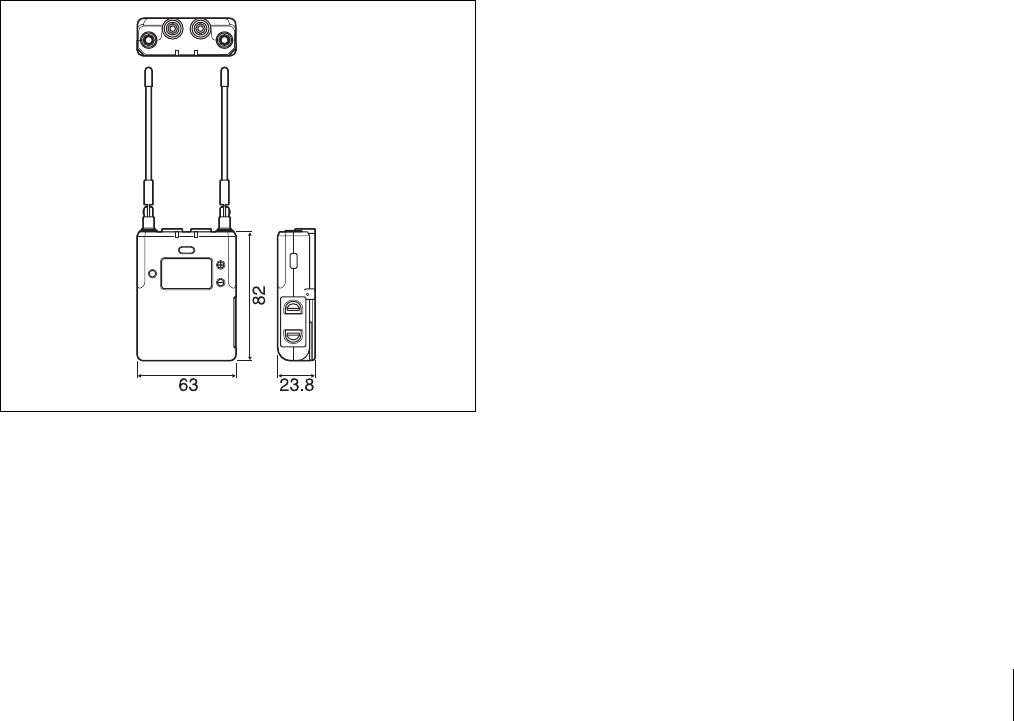
Specifications 37
Model available in China:
710 MHz to 782 MHz (CN38 model)
Model available in Korea:
925 MHz to 937.5 MHz (KR Model)
Model available in Thailand and
Taiwan:
794 MHz to 806 MHz (E model)
Signal-to-noise-ratio
60 dB or more
Voice delay 0.35 ms
Deemphasis 50 μs
Reference frequency deviation
±5 kHz
Frequency response
40 Hz to 18 kHz
Distortion 0.9% or less (5 kHz modulation)
Tone signal In UWP-D compander mode:
32.382 kHz
In UWP compander mode: 32 kHz
In WL800 compander mode:
32.768 kHz
Indicators POWER, RF
Operating temperature
0 °C to 50 °C (32 °F to 122 °F)
0 °C to 35 °C (32 °F to 95 °F) when
charging
Storage temperature
–20 °C to +55 °C (–4 °F to +131 °F)
Supply voltage 3.0 V DC (two LR6/AA size alkaline
batteries)
5.0 V DC (supplied from USB
connector)
Battery life Approx. 6 hours (measured with two
Sony LR6/AA size alkaline batteries
at 25 °C (77 °F))
Dimensions
63 × 82 × 23.8 mm
(2 1/2 × 3 1/4 × 15/16 in.)
(Width / height / depth)
(excluding antenna)
Mass Approx. 136 g (4.8 oz)
(excluding batteries)

Sony Corporation